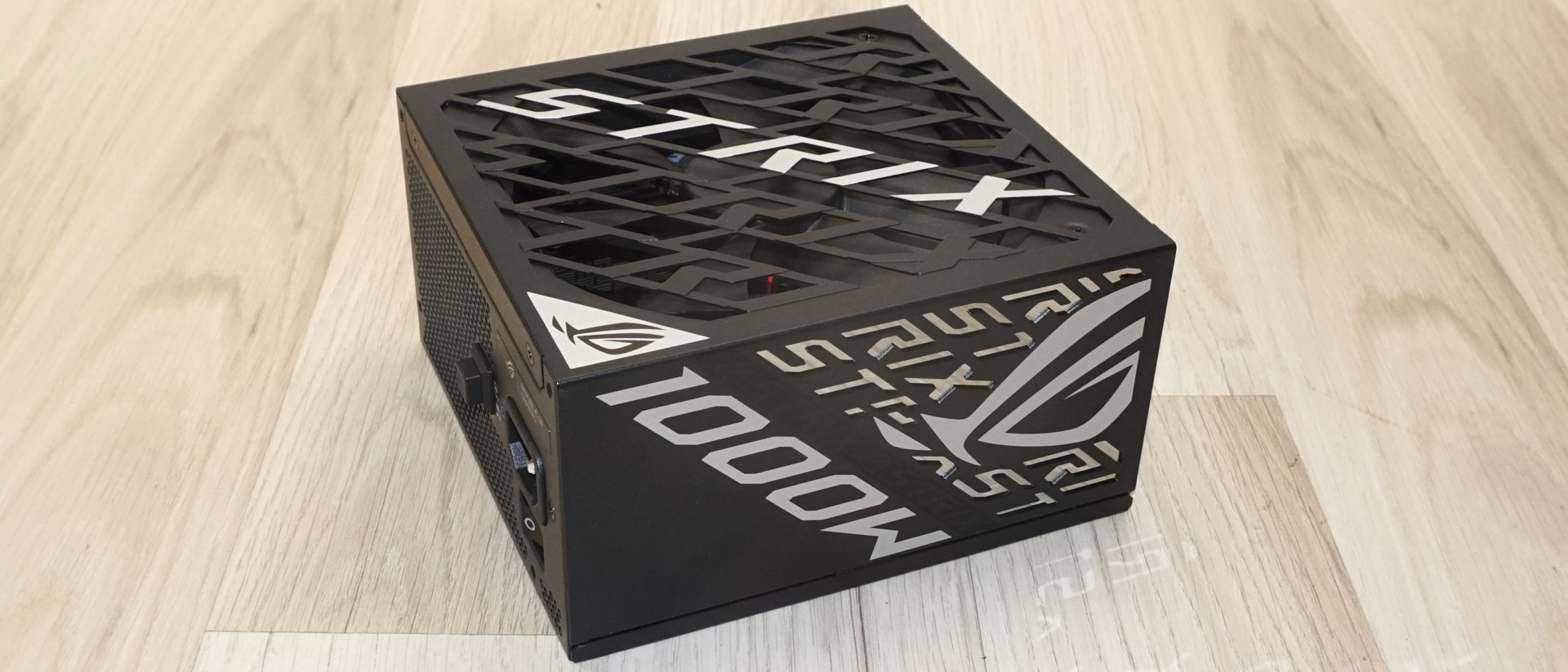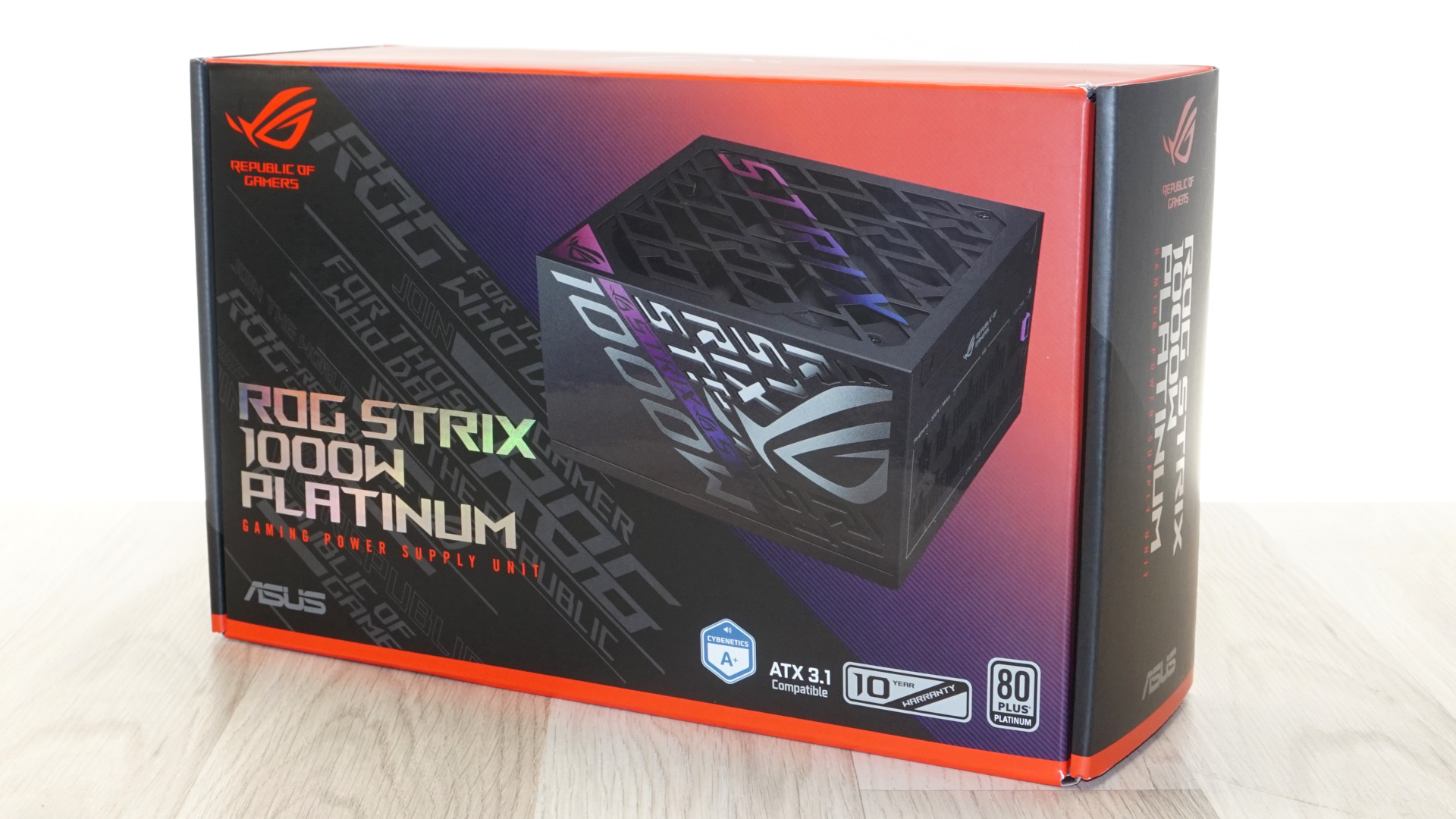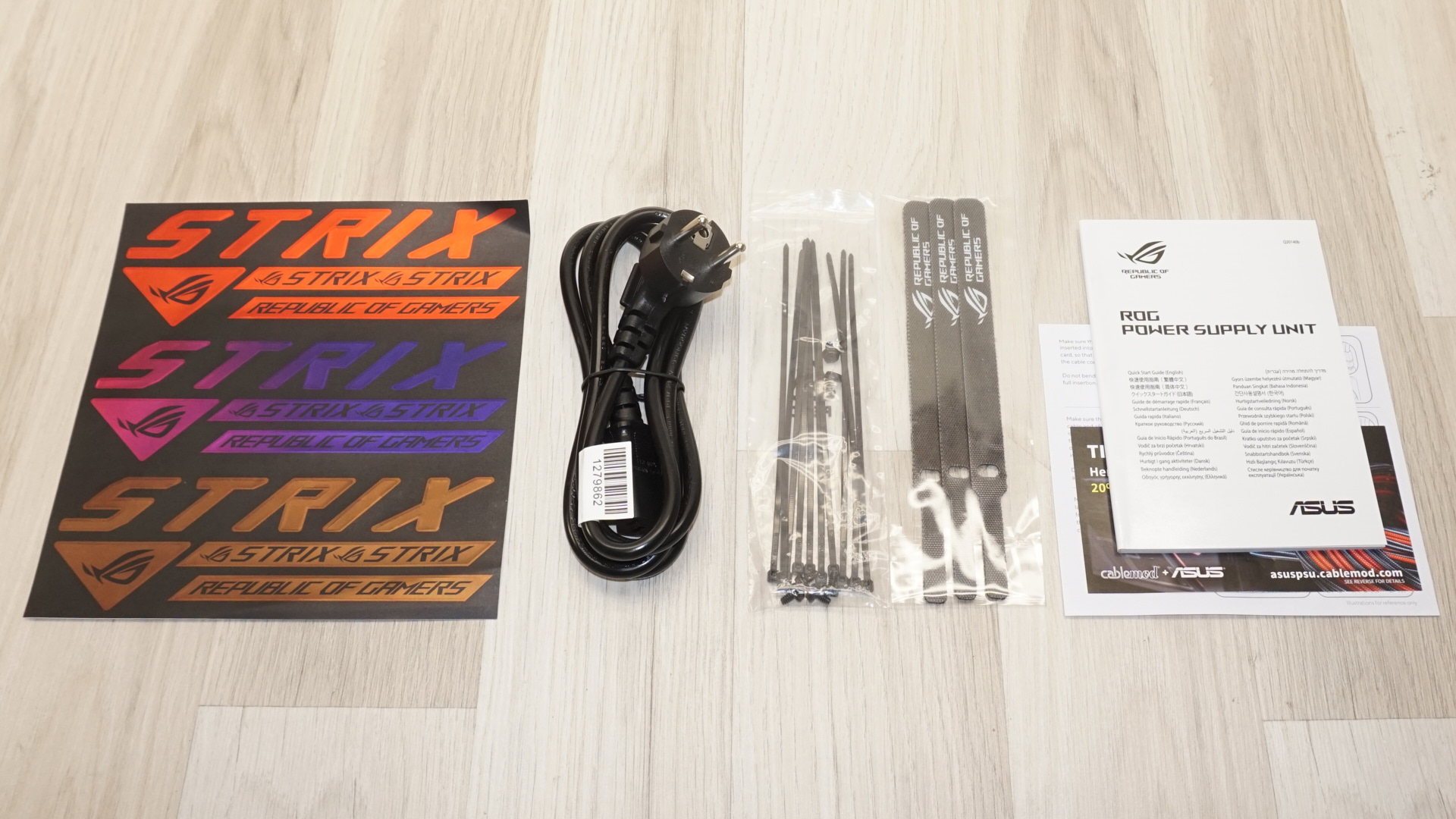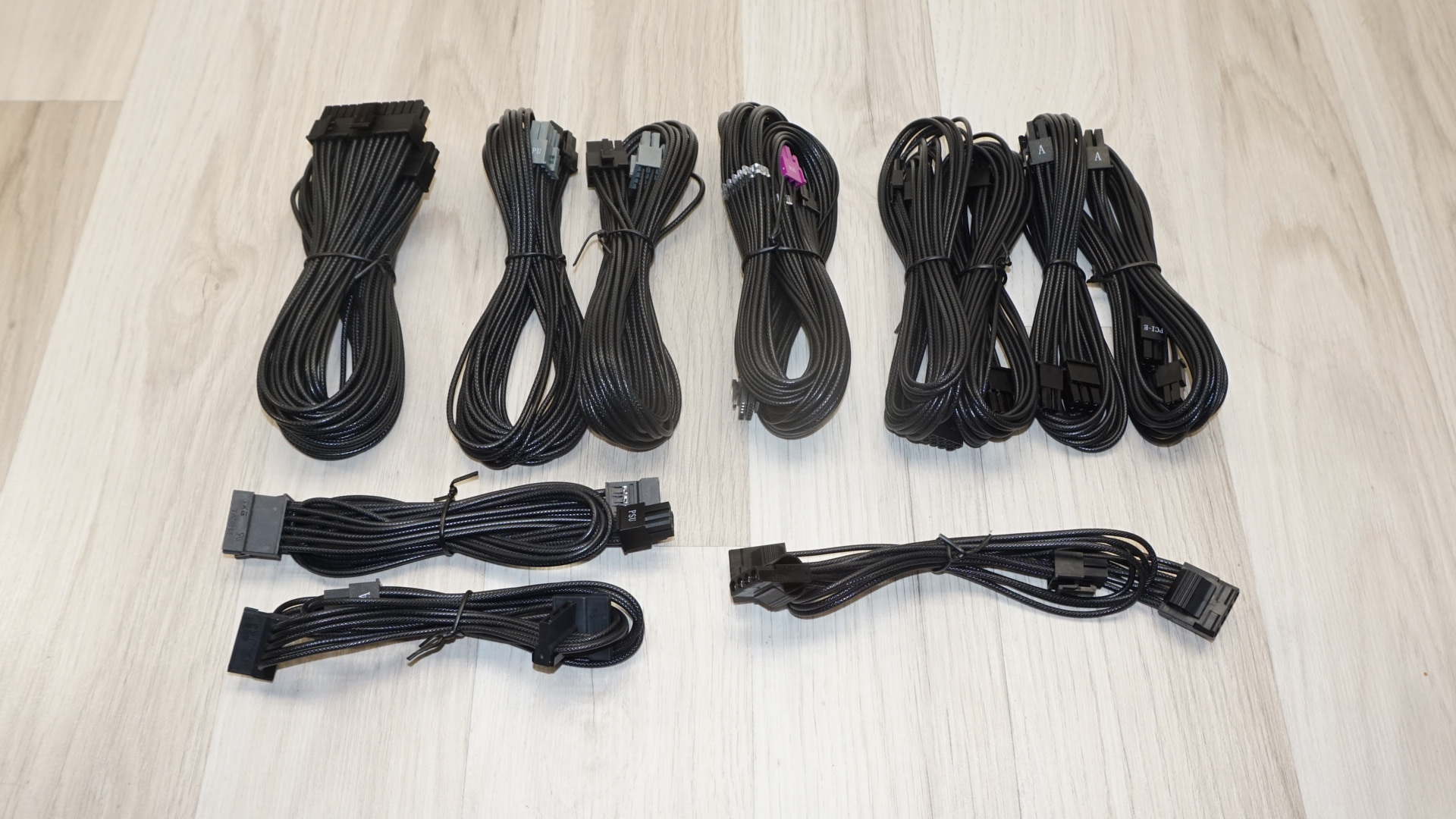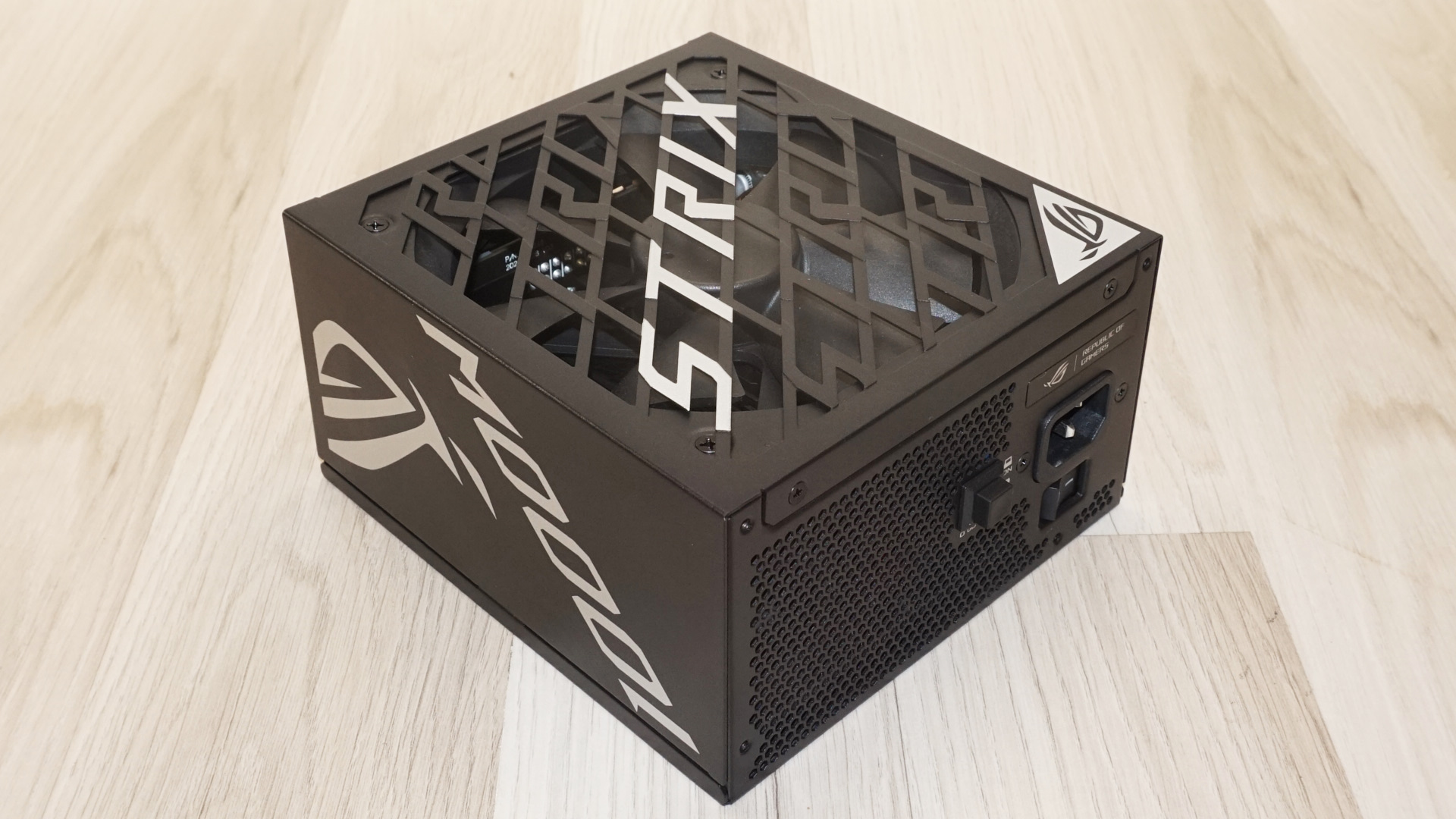Tom's Hardware Verdict
The Asus ROG Strix 1000P delivers excellent electrical and thermal performance in a highly stylized package. While the price is steep, it justifies its cost with premium components, customization options, and a 10-year warranty, though some features prioritize appearance over practicality.
Pros
- +
ATX 3.1 / PCIe 5.1 compliant
- +
10-year warranty
- +
Premium build quality
- +
Very low noise levels
- +
Full protection features
- +
Flexible cable design
- +
Outstanding power quality
- +
Remarkable efficiency for its class
Cons
- -
High price
- -
Limited number of connectors
- -
Gimmicky features
Why you can trust Tom's Hardware
Asus is a globally recognized technology leader, renowned for delivering high-performance hardware solutions across a broad spectrum of consumer and enthusiast markets. With decades of engineering experience and a well-established presence in the gaming industry through its Republic of Gamers (ROG) brand, Asus’ product portfolio spans motherboards, graphics cards, displays, peripherals, and power supply units, with a myriad of products seeking to cater to everyone’s needs.
We examine the Asus ROG Strix 1000P to determine if it deserves a spot in our best power supplies list. The Strix 1000P is a visually extravagant premium ATX 3.1 power supply unit that targets PC gamers and younger audiences. Developed in collaboration with Great Wall, one of the most reputable OEMs in the power supply industry, it combines visual flair with modern power delivery technologies, a fully modular interface, and compliance with the latest ATX specifications.
Specifications and Design
RAIL | +3.3V | +5V | +12V | +5Vsb | -12V |
MAX OUTPUT | 25A | 25A | 83.3A | 3A | 0.3A |
| Row 2 - Cell 0 | 130W | Row 2 - Cell 2 | 1000W | 15W | 3.6W |
TOTAL | 1000W | Row 3 - Cell 2 | Row 3 - Cell 3 | Row 3 - Cell 4 | Row 3 - Cell 5 |
AC INPUT | 100 - 240 VAC, 50 - 60 Hz | Row 4 - Cell 2 | Row 4 - Cell 3 | Row 4 - Cell 4 | Row 4 - Cell 5 |
PRICE | $280 | Row 5 - Cell 2 | Row 5 - Cell 3 | Row 5 - Cell 4 | Row 5 - Cell 5 |
In the Box
We received the ROG Strix 1000P in a large, rigid cardboard carton with fancy, colorful artwork covering all sides. Upon opening, the PSU is snugly contained within a nylon pouch, with thick foam inserts on all sides to prevent damage during shipping.
Accompanying the unit is a thoughtfully curated accessory set. Asus includes a standard AC power cable, black mounting screws, multiple nylon cable ties for basic bundling, and three reusable Velcro‑style cable straps. Additionally, users receive an assortment of stickers in alternate accent colors, enabling personalization of the chassis cutouts.
The Strix 1000P’s fully modular cables are individually sleeved, matching the connectors’ black housings. All standard cables — 24‑pin ATX, 8‑pin EPS, PCIe, SATA, and peripheral — feature consistent black wiring and fitting. The sole exception is the 12 V‑2×6 pin PCIe cable, which integrates a purple 2‑pin voltage‑sense connector to monitor GPU voltage and dynamically adjust output. Cable flexibility is excellent, thanks to thin‑gauge sleeving and high‑strand‑count conductors, facilitating clean routing and tight bends with minimal mechanical resistance. The total quantity of connectors is very conservative for a unit of this power output.
Connector type | Hardwired | Modular |
|---|---|---|
ATX 24 Pin | - | 1 |
EPS 4+4 Pin | - | 2 |
EPS 8 Pin | - | - |
PCI-E 5.0 | - | 1 |
PCI-E 8 Pin | - | 4 |
SATA | - | 6 |
Molex | - | 3 |
Floppy | - | - |
External Appearance
At 160 mm in length, the Strix 1000P slightly exceeds the ATX specification by 10 mm but remains compatible with the vast majority of mid‑tower and full‑tower chassis. The reviewed black variant is finished in a uniform satin‑black powder coat that resists fingerprints and minor abrasions. Asus placed significant effort into making the unit stand out visually. The fan intake is covered by an integrated steel grille featuring repeated “STRIX” cutouts, clearly forgoing aerodynamics for brand reinforcement.
Aggressive decorative cutouts with polished chrome inserts cover the sides of the housing, creating strong visual contrast. Users can use the included stickers to replace the chrome parts with colors, if they so wish. A triangular, half‑panel sticker on the top surface lists the electrical specifications and certifications of the unit.
Get Tom's Hardware's best news and in-depth reviews, straight to your inbox.
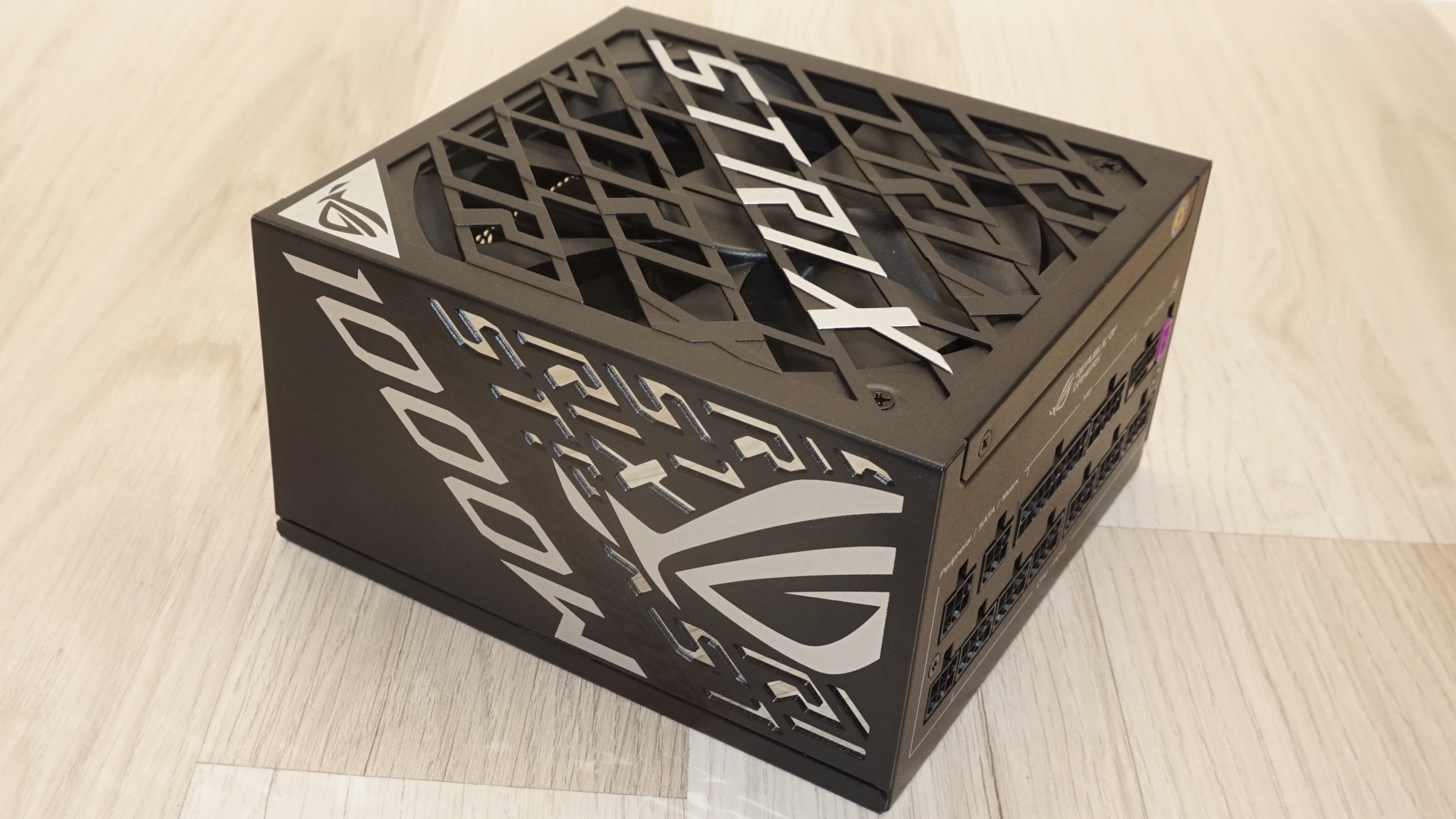
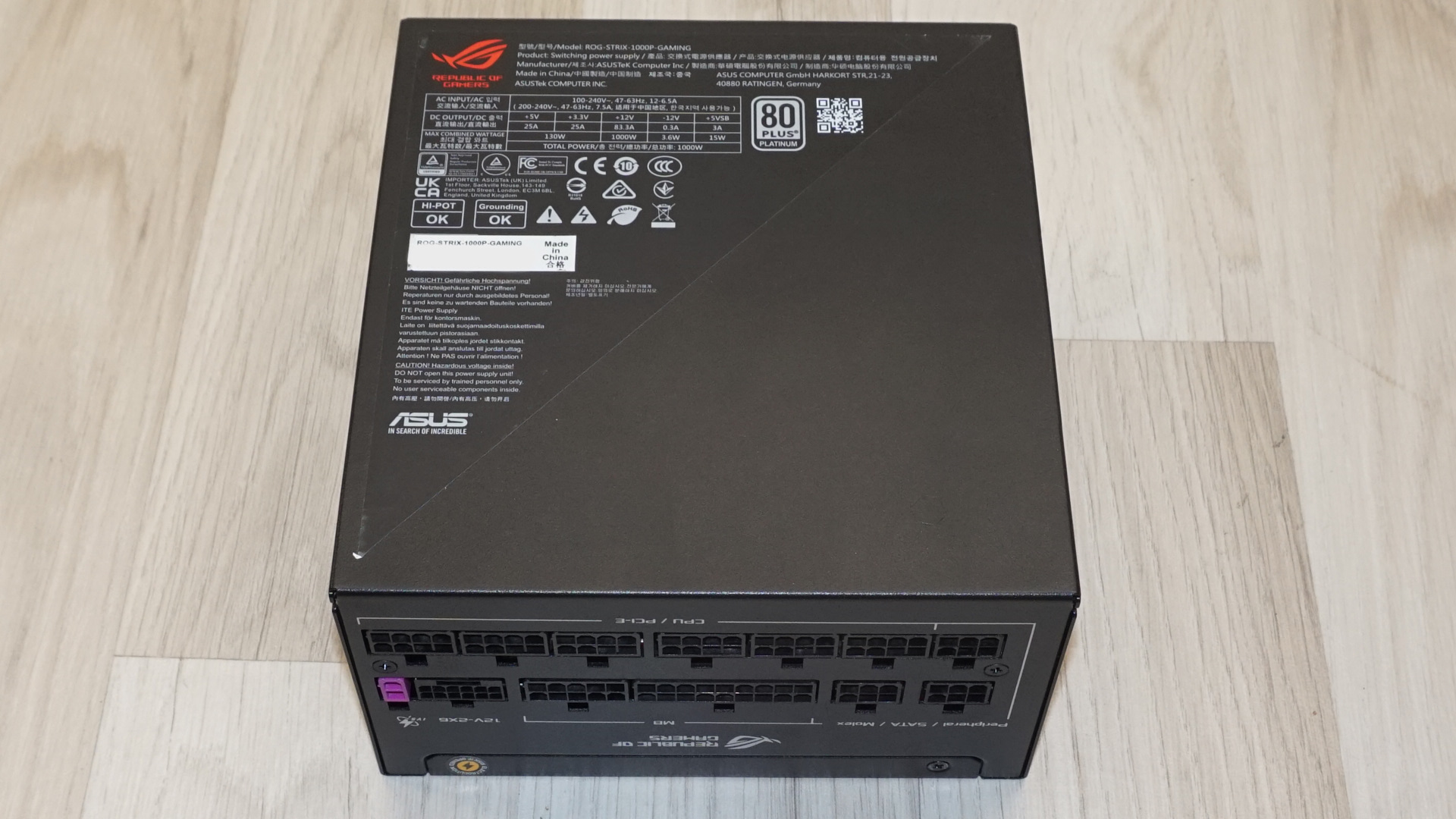
On the rear, the AC inlet and rocker‑style on/off switch occupy the left side, followed by a toggle switch to engage or disengage Asus’s hybrid fan mode. The front of the unit is littered with the connectors for the modular cables, with a basic legend etched around them. Above the connectors, Asus subtly etched a ROG logo.
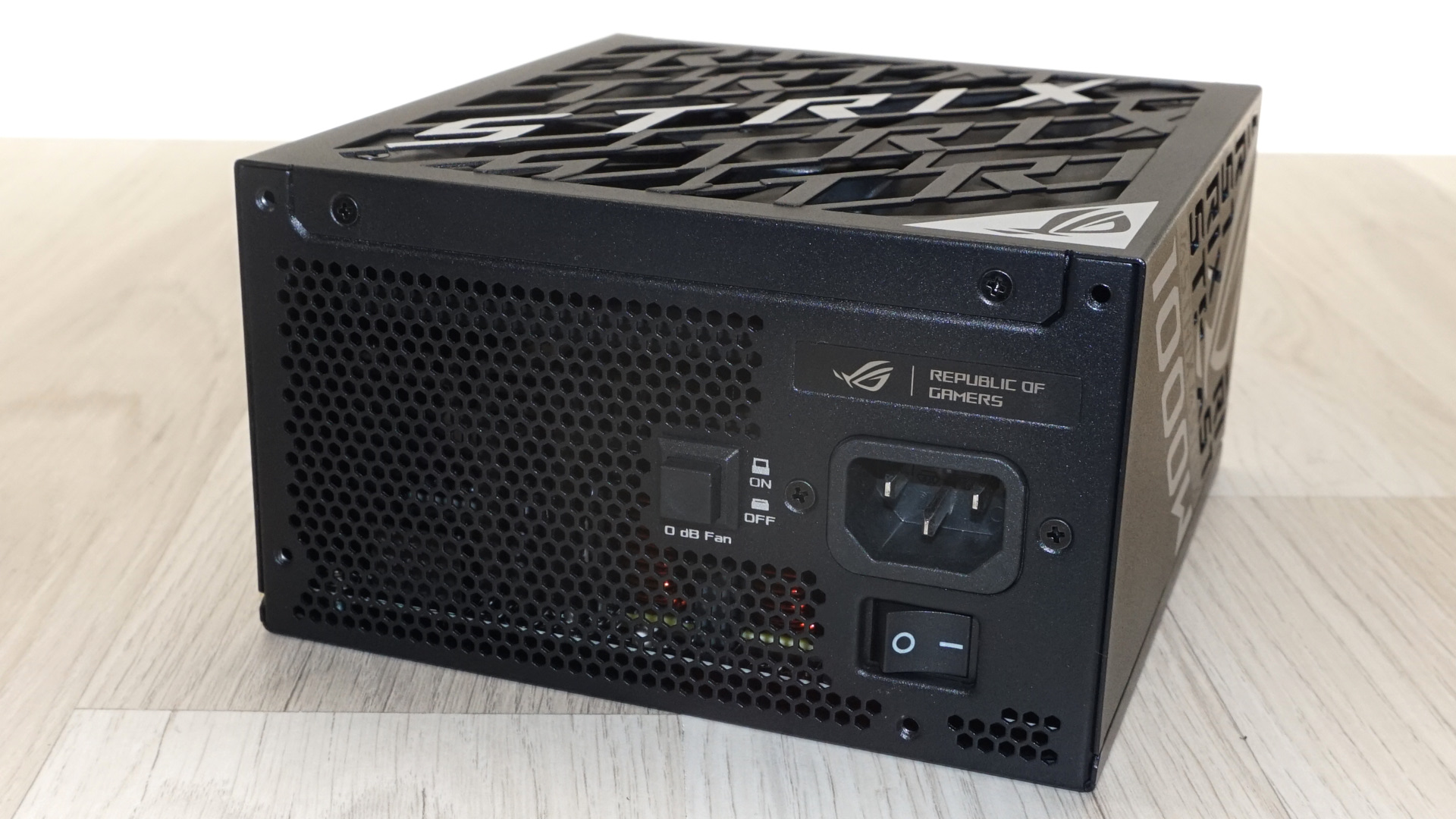
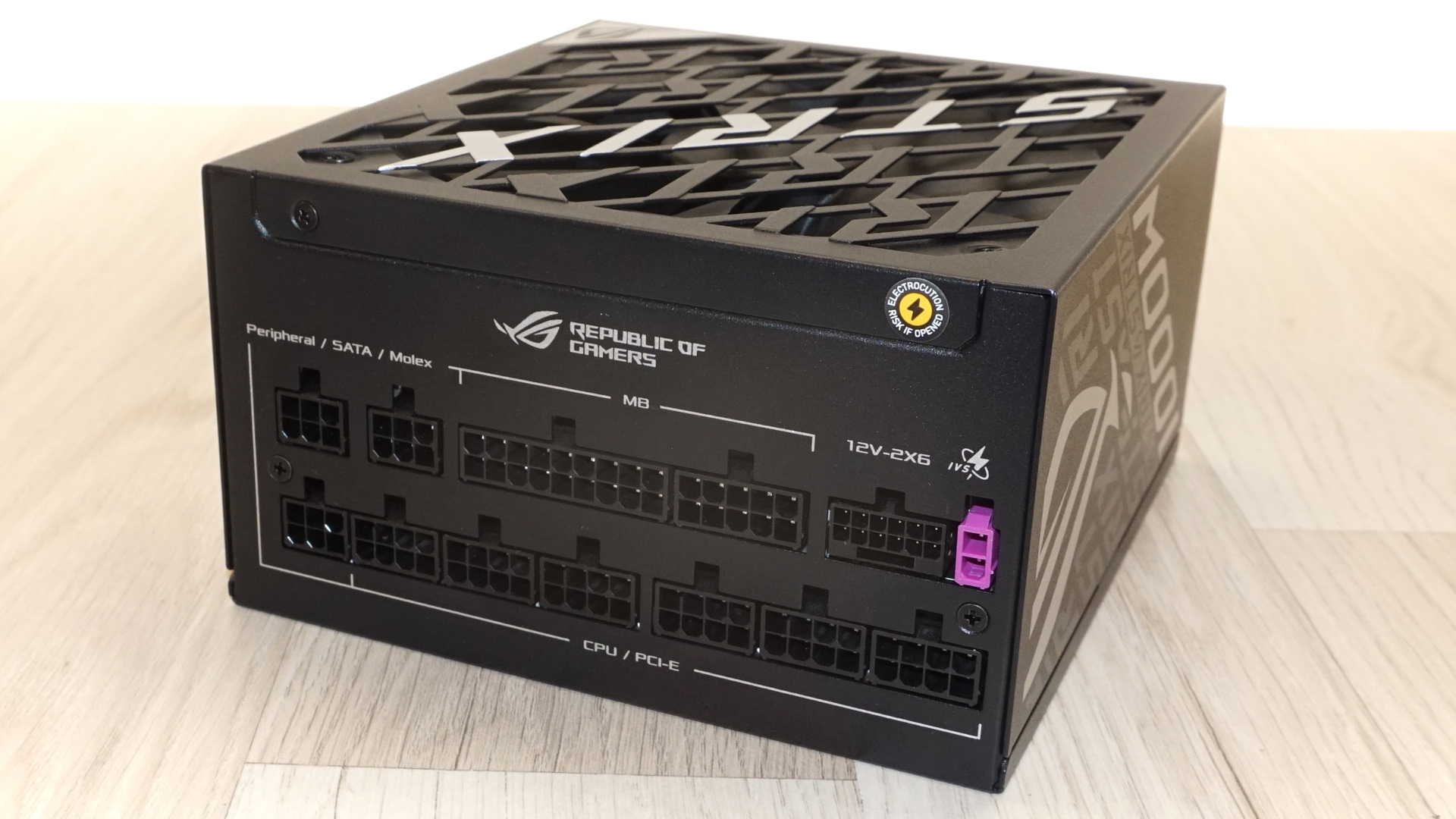
Internal Design
The heart of the Strix 1000P’s thermal management is a Champion CF1325L12D 135 mm dual‑ball‑bearing fan. With a relatively low maximum speed of 1600 RPM, the dual-ball bearing fan offers superior long‑term reliability and temperature resilience compared to sleeve‑bearing counterparts. Dual‑ball bearings, however, are typically loud at higher speeds and thus manufacturers tend to avoid using them. Taking into consideration that Asus is also boasting about this unit’s thermal performance, it is very odd that they opted for a ball-bearing fan at all.
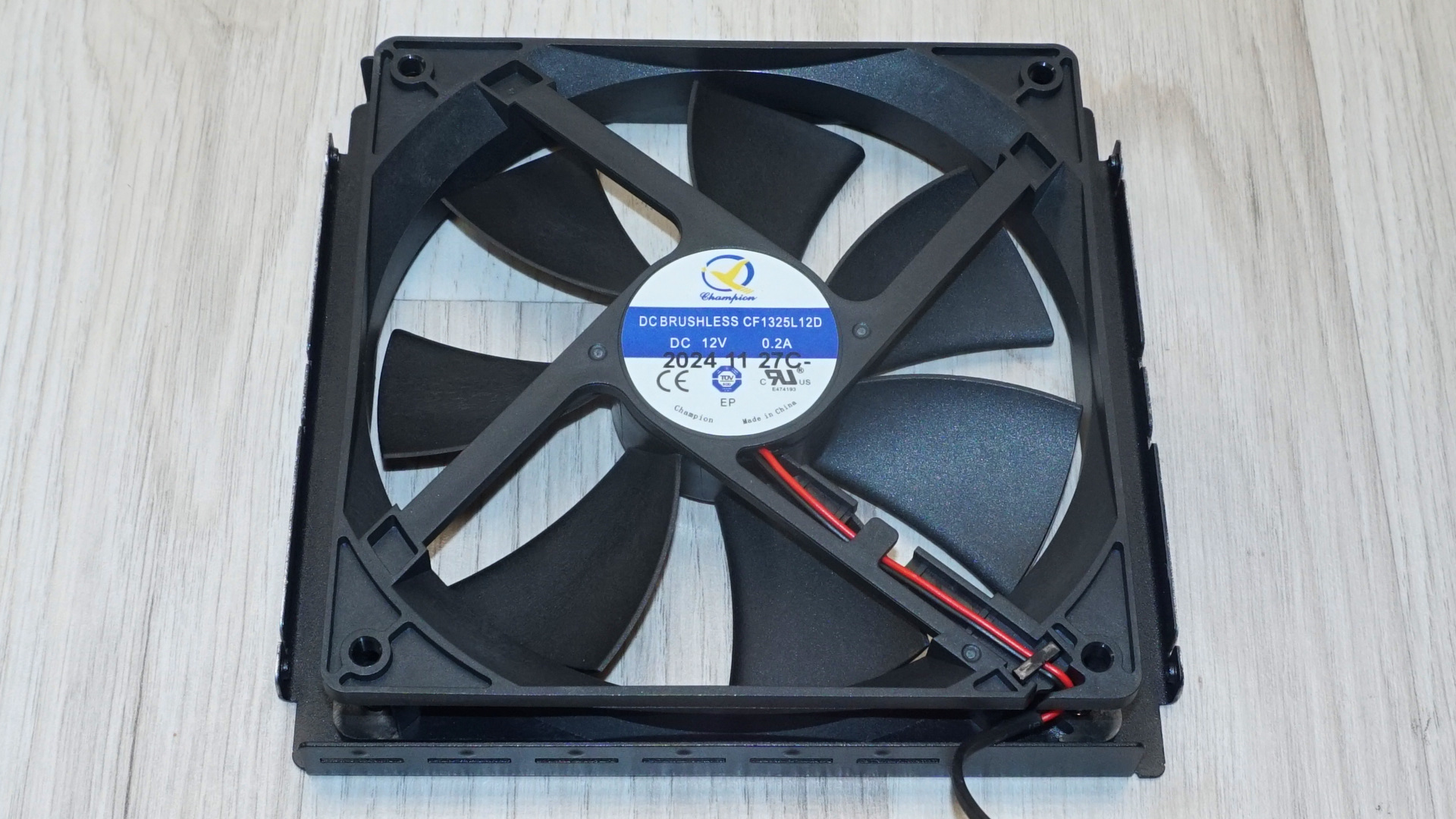
The OEM behind the creation of the ROG Strix 1000P is Great Wall, one of the most popular Chinese OEMs of PC PSUs. Its platforms are more commonly found behind top-tier products.
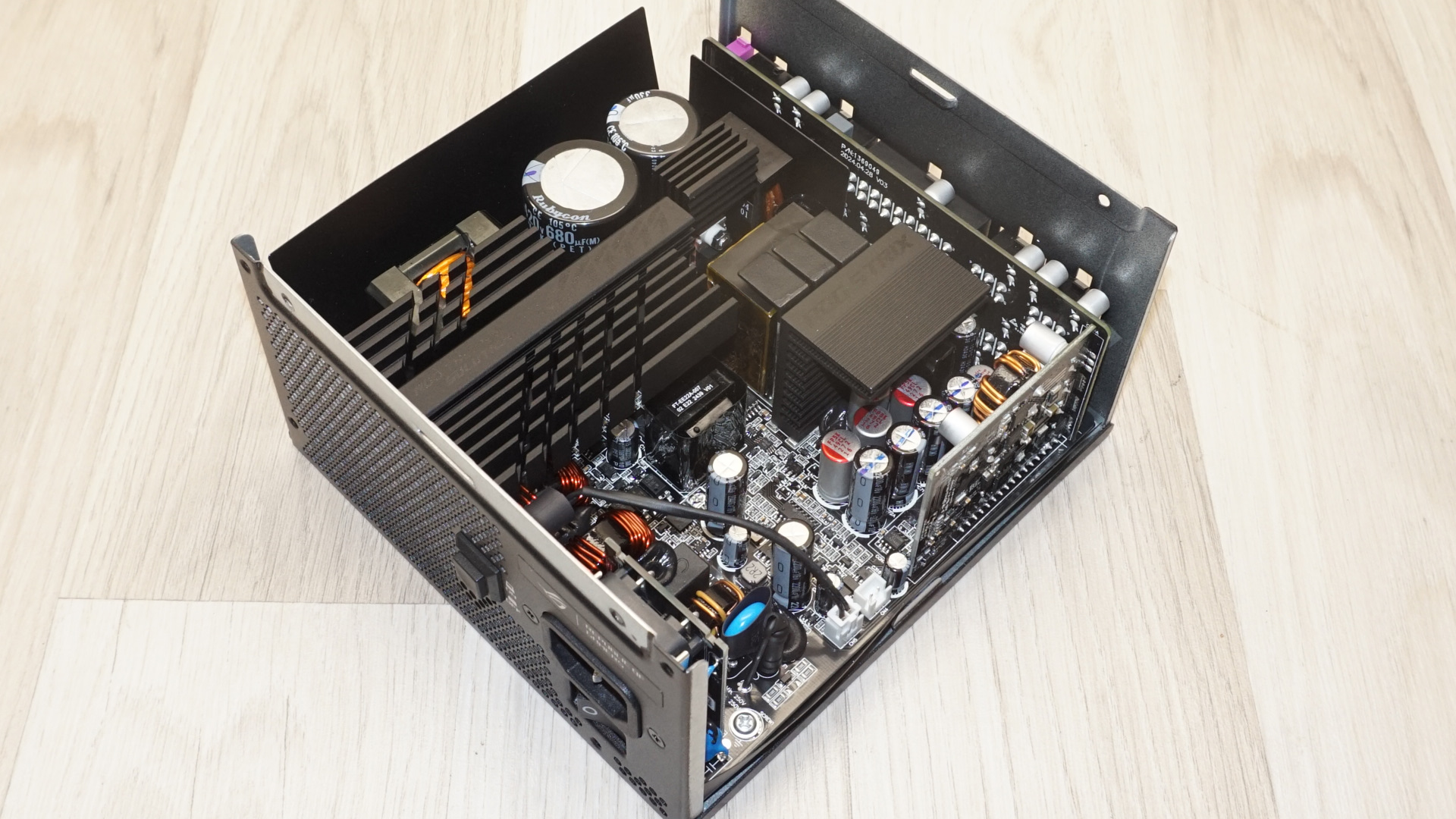
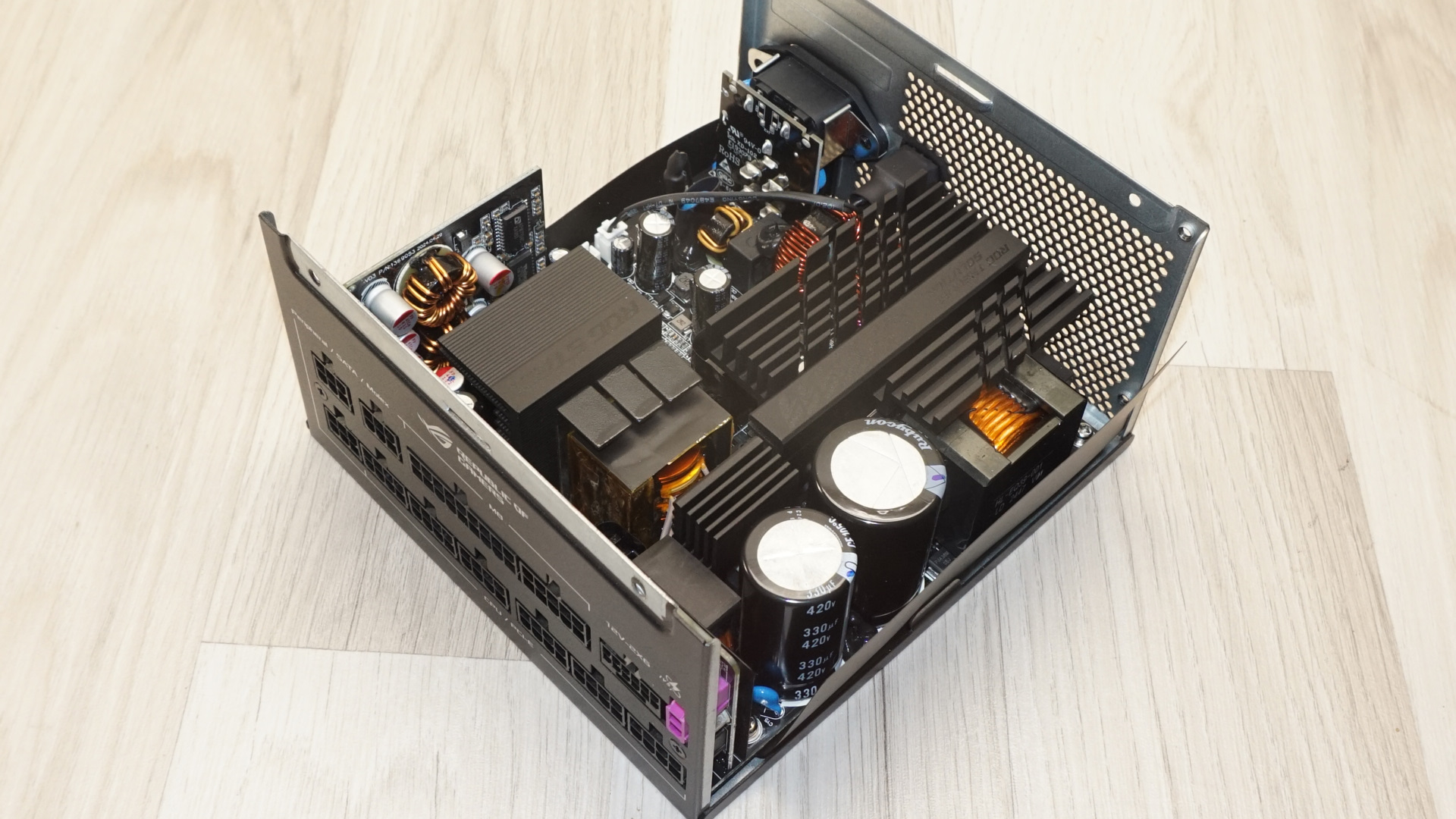
The unit’s input filtering stage consists of four Y capacitors, two X capacitors, and two filtering inductors, forming a fairly standard configuration for a 1000W PSU. Two rectifying bridges are mounted on a fairly large heatsink following the filtering stage. The Active Power Factor Correction (APFC) stage resides on the primary “ROG” heatsink, which occupies roughly 30 % of the internal volume. It employs a GaN MOSFET paired with a fast‑recovery diode to minimize switching losses at high frequencies. Passive PFC components include a Rubycon 680 µF capacitor, a Nichicon 330 µF capacitor, and an encased inductor.
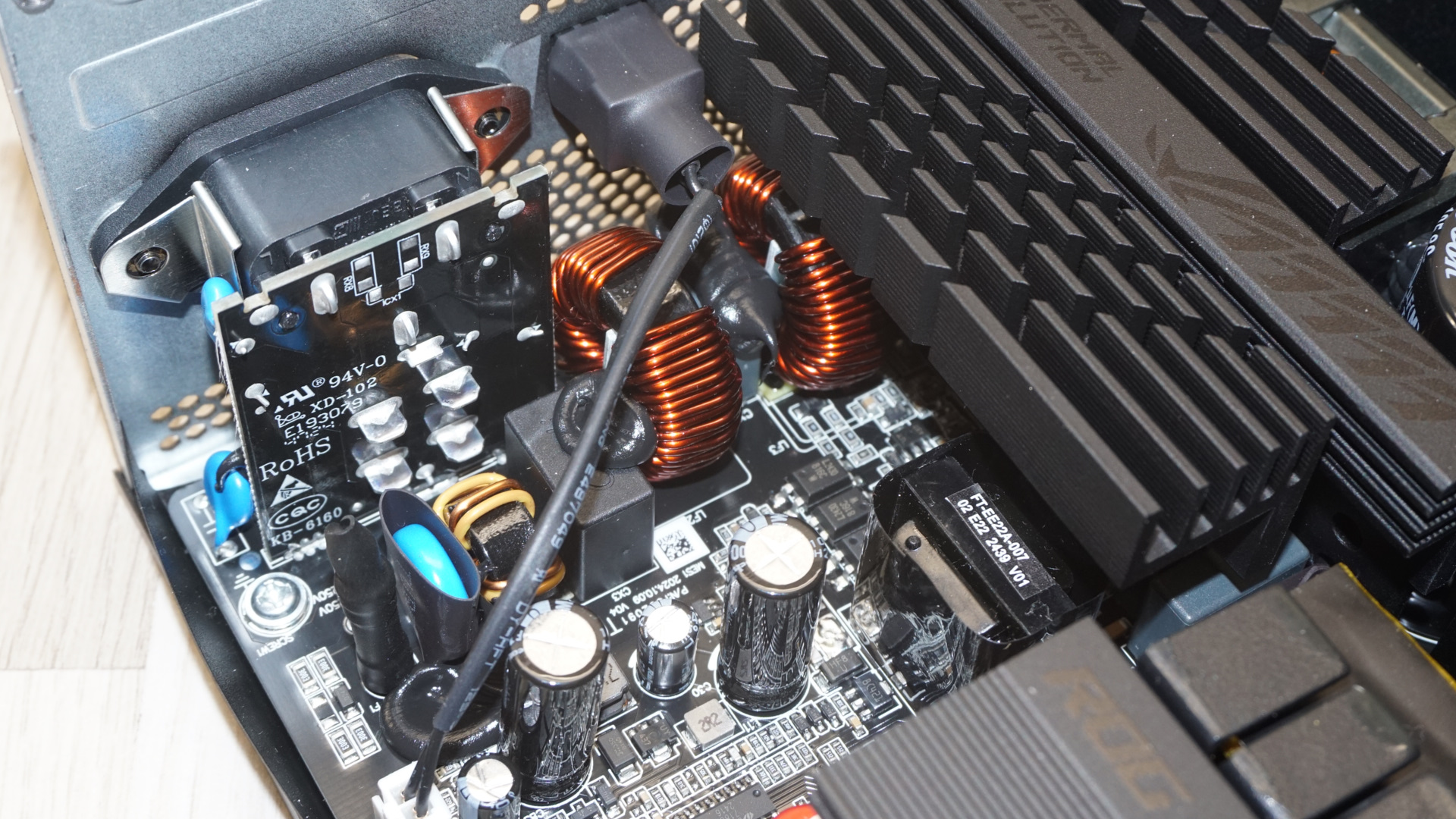

The primary inversion stage uses a half‑bridge LLC topology, with two R6035VNX3 MOSFETs mounted on another large heatsink near the primary transformer. On the secondary side, six MOSFETs found on a vertical PCB right next to the transformer generate the primary 12V line, with a large dedicated heatsink tightly attached to them. DC-to-DC circuits on a large vertical daughterboard generate the 3.3V and 5V lines.
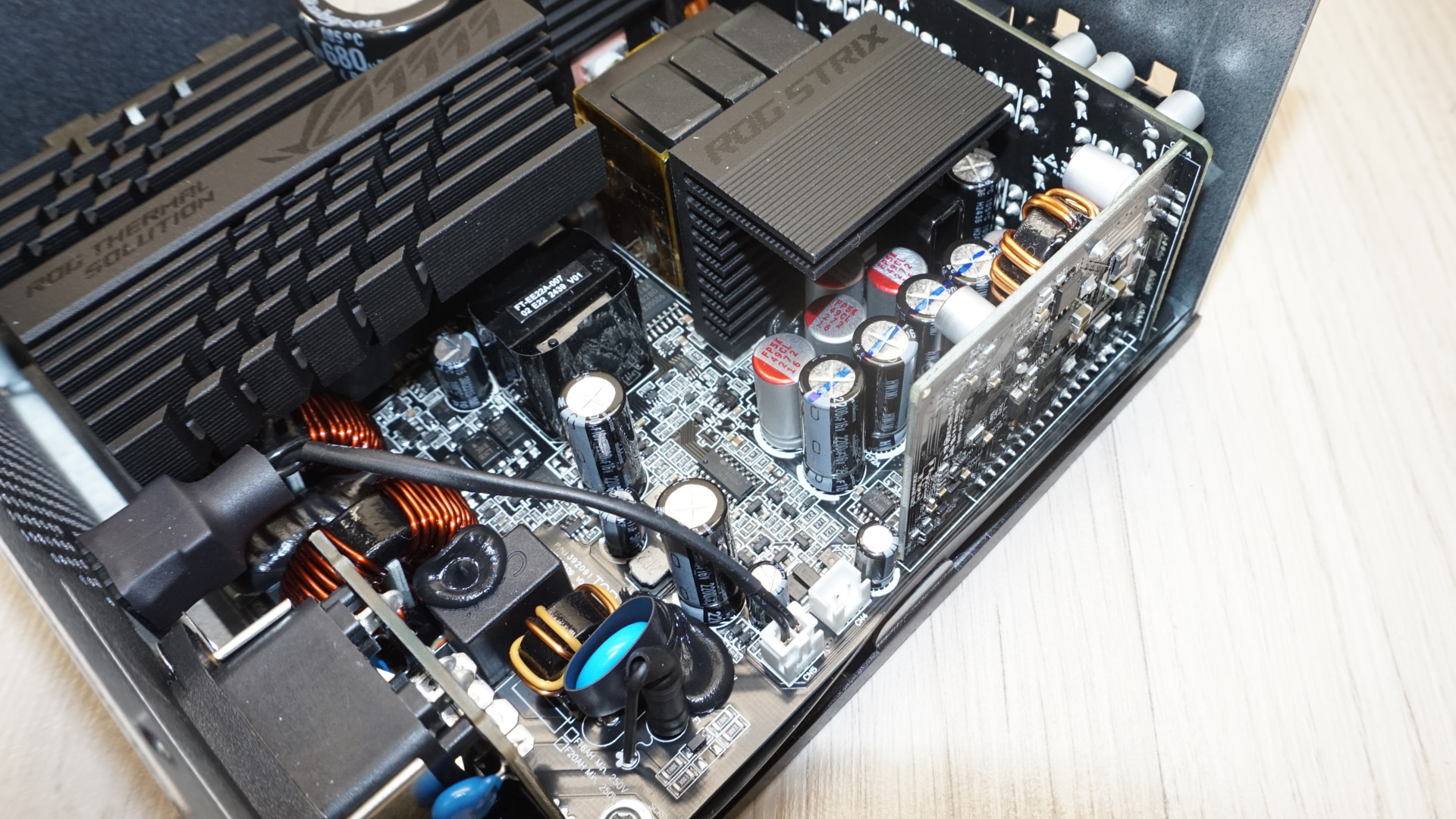
The secondary side capacitors are a mix of Nippon Chemi-Con, Nichicon and Rubycon products. There are a few electrolytic capacitors but most are solid-state products. All come from top-tier Japanese manufacturers. The unit’s heatsinks are massive for a unit of this power output and efficiency.
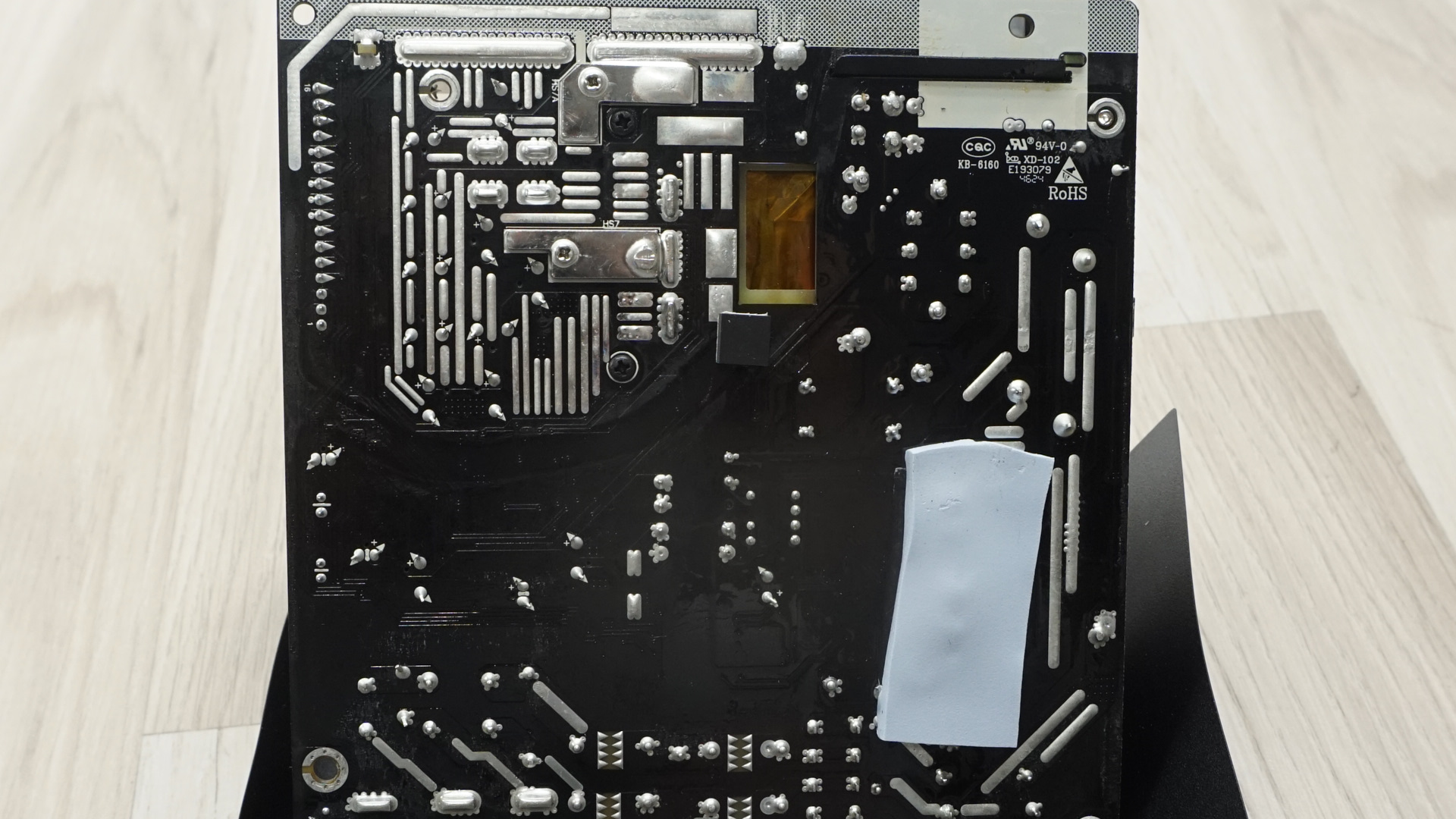
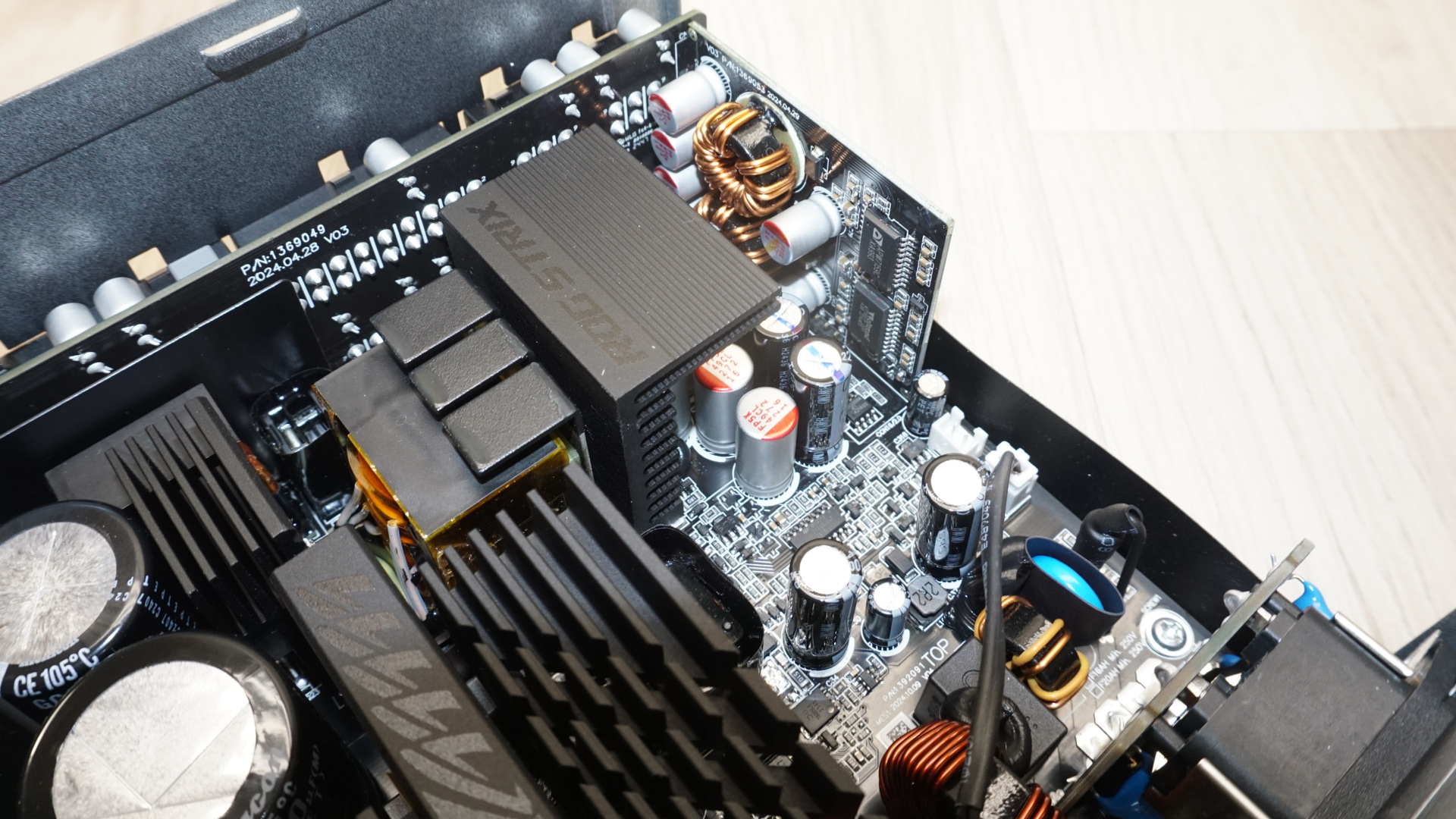
Cold Test Results
Cold Test Results (25°C Ambient)
For testing of power supplies, we use high precision electronic loads with a maximum power draw of 2700 Watts, a Rigol DS5042M 40 MHz oscilloscope, an Extech 380803 power analyzer, two high precision UNI-T UT-325 digital thermometers, an Extech HD600 SPL meter, a self-designed hotbox, and various other bits and parts.
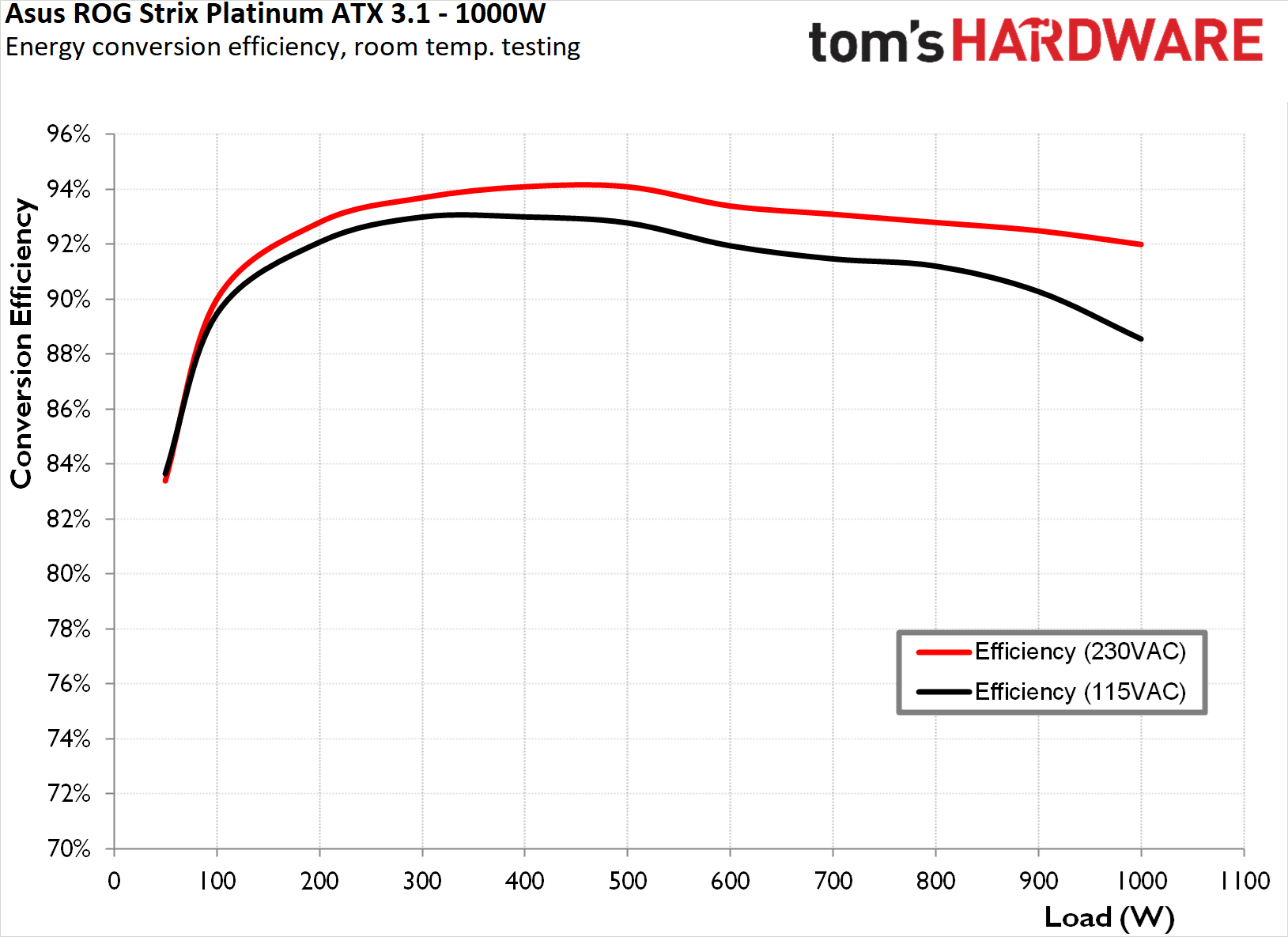
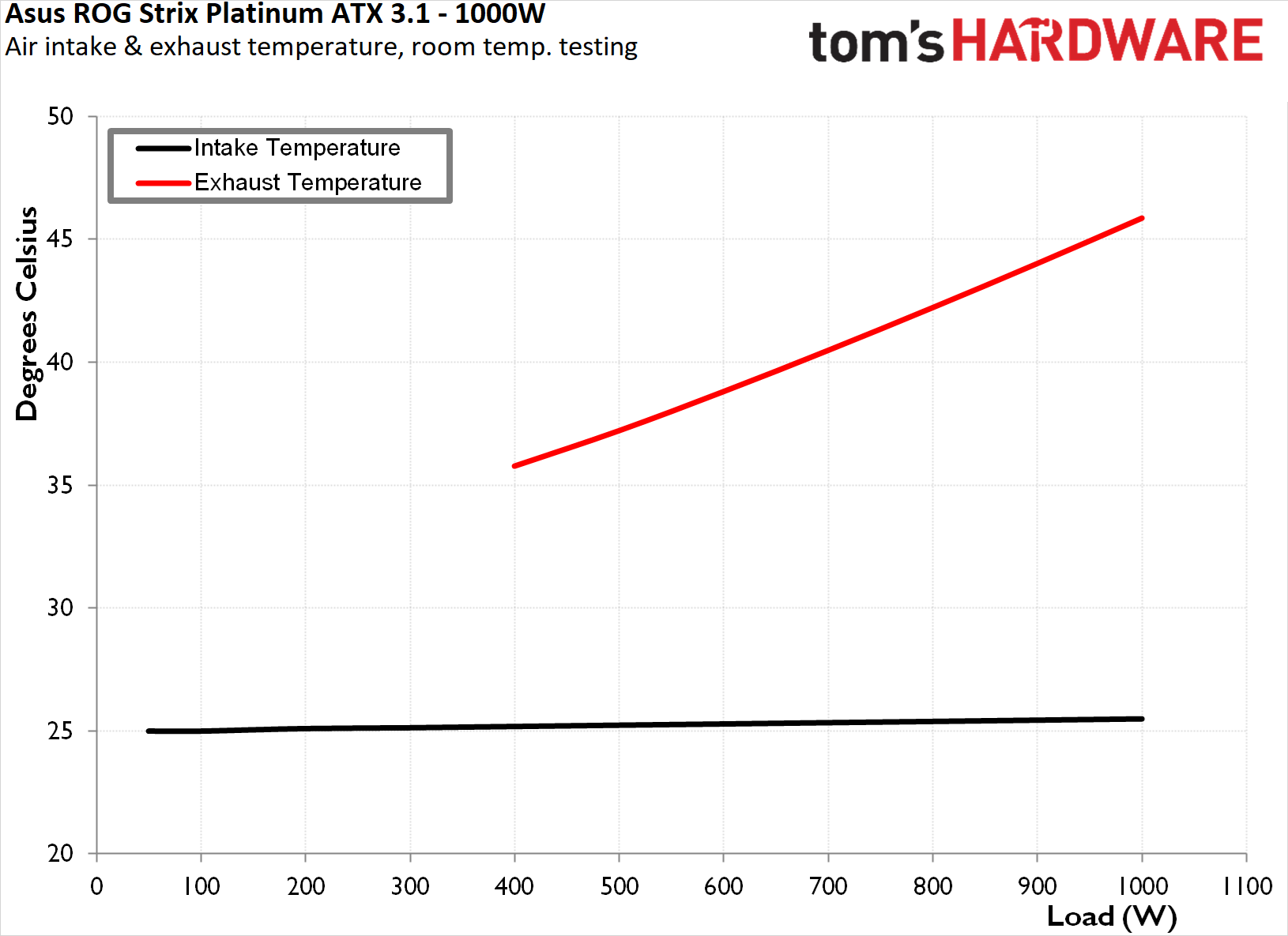
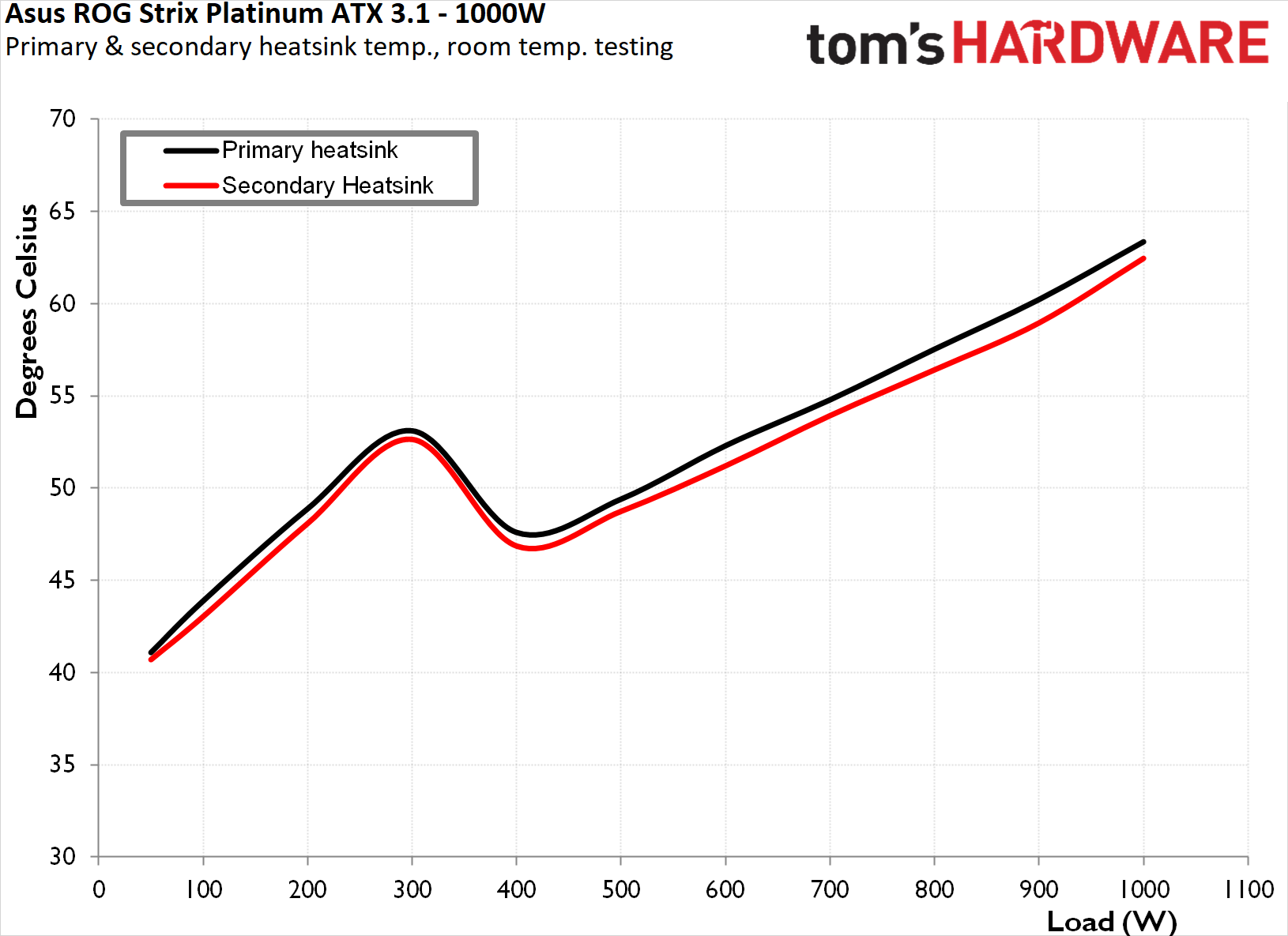
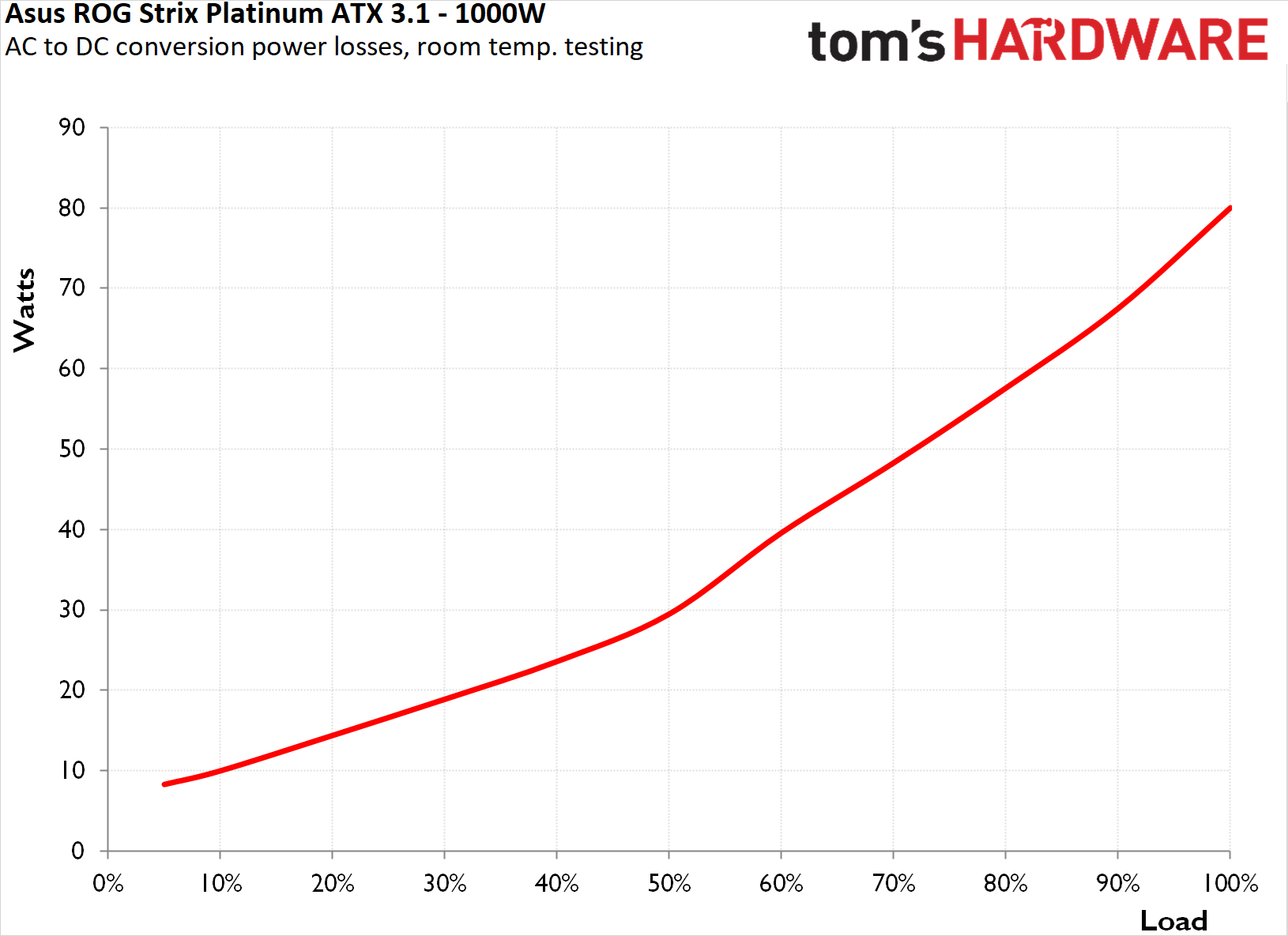
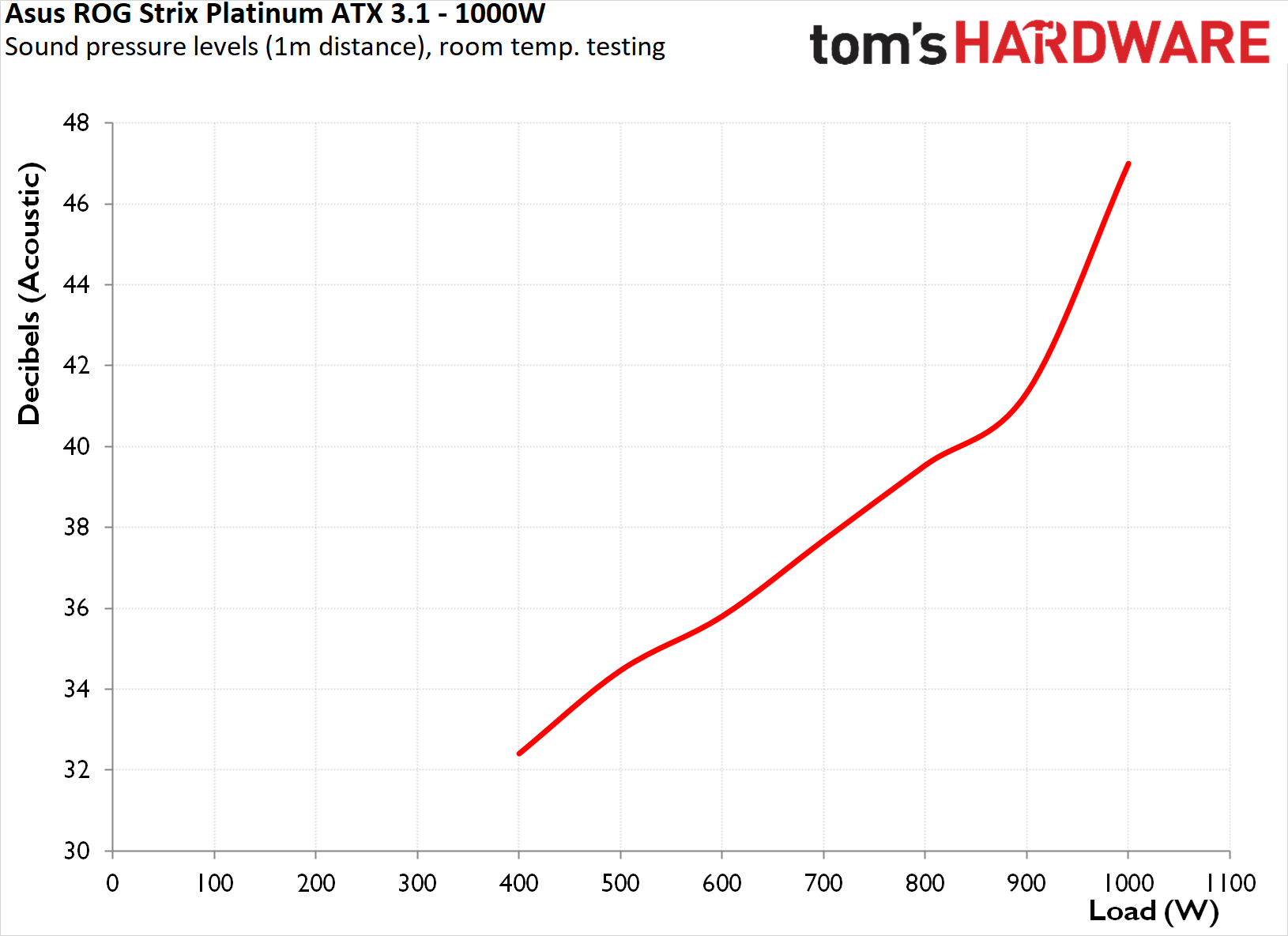
Under these conditions, the ROG Strix 1000P achieved 91.4 % average efficiency at 115 VAC and 92.9 % at 230 VAC across the 10 % to 100 % load range, comfortably meeting and exceeding 80Plus Platinum and Cybenetics Platinum requirements. The highest efficiency point was recorded at roughly 45 % load, where efficiency peaked at 94.2%. The unit is also highly efficient at very low loads, especially with a 115 VAC power supply.
The fan does not engage until the load is greater than 400 watts, eliminating audible noise. Beyond this threshold, the fan begins spinning and speeds up linearly alongside the load, making a sharp jump at maximum load but never going anywhere near its maximum speed. Relatively speaking, noise figures are very low for a 1000W PSU, as are the unit’s internal temperatures.
Hot Test Results
Hot Test Results (~45°C Ambient)
In our custom hotbox environment, the Strix 1000P’s average efficiency decreased marginally to 90.8 % at 115 VAC and 92.2 % at 230 VAC. The most pronounced efficiency decline was at mid‑load (50 %), where it dropped to 93.5%, representing a 0.7% reduction from cold‑room measurements. The unit showed absolutely no signs of thermal stressing.
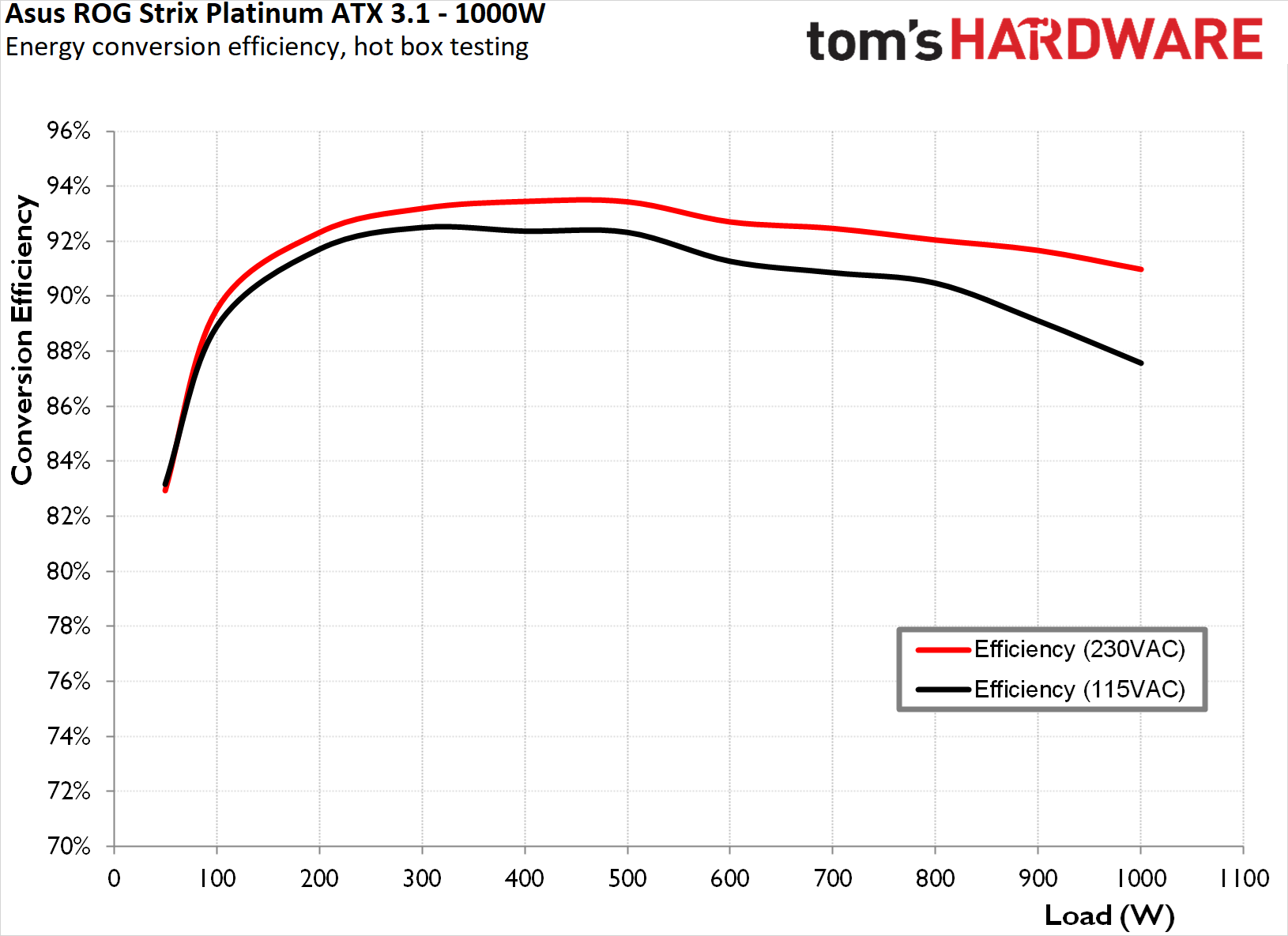
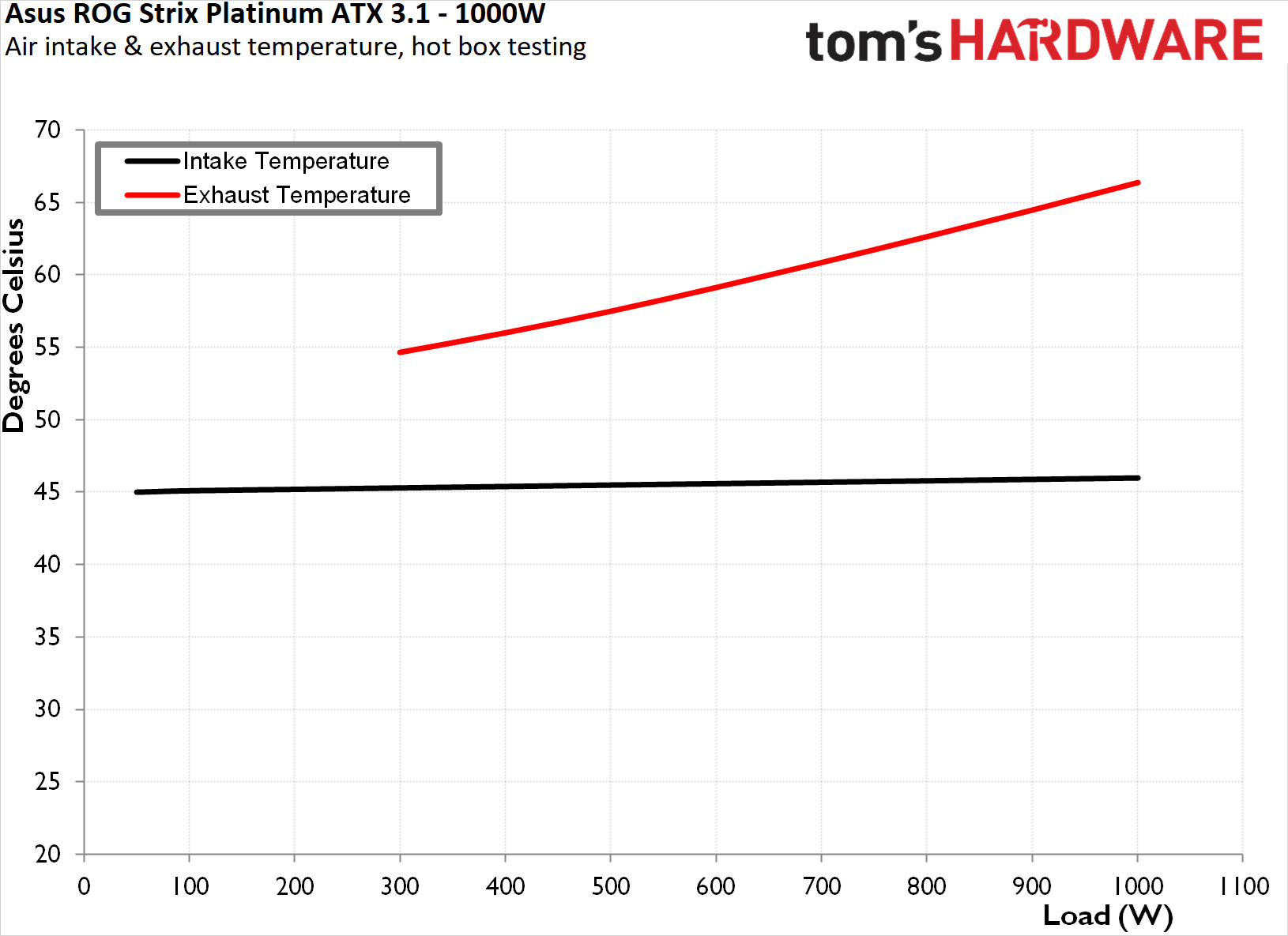
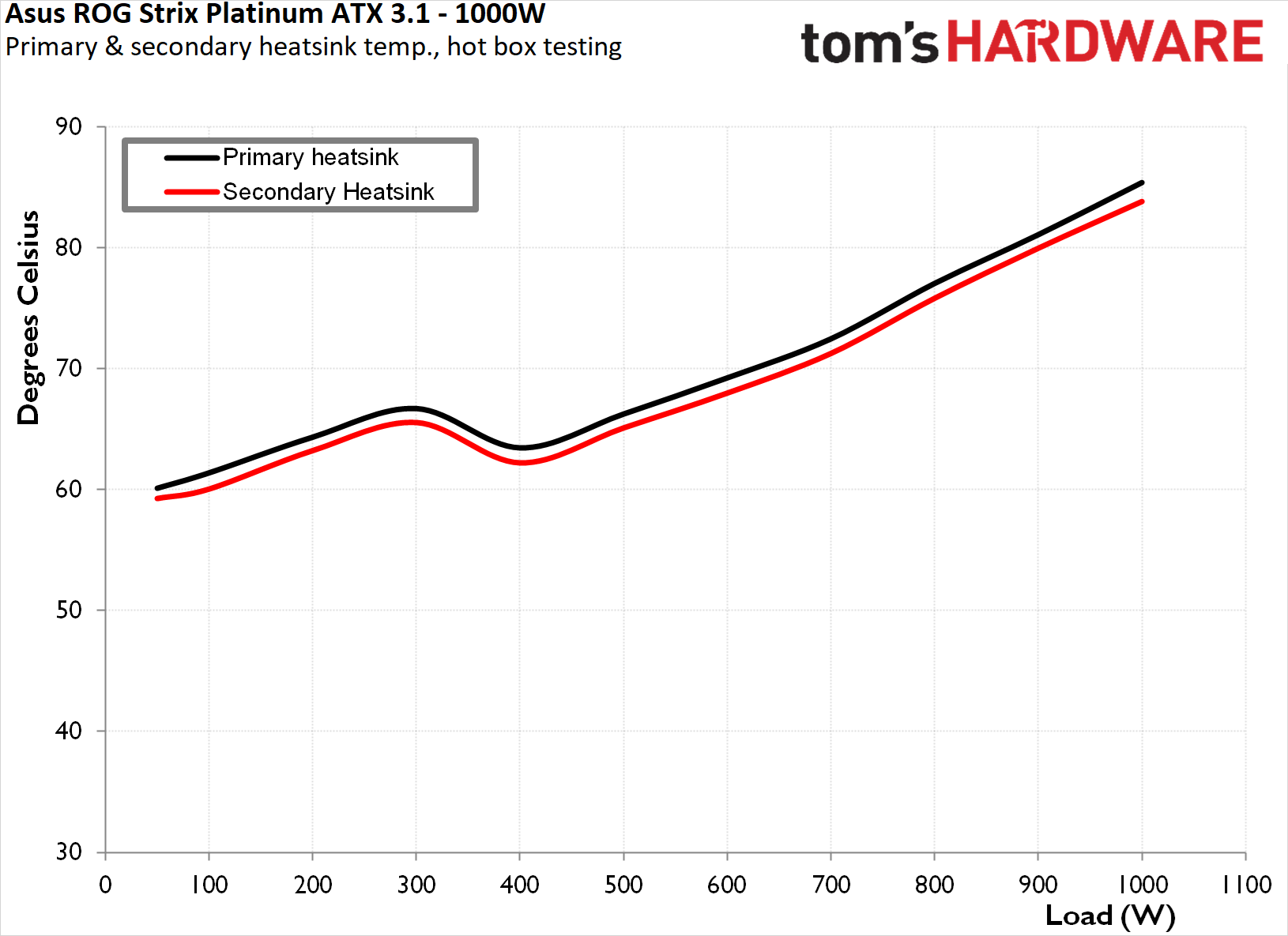

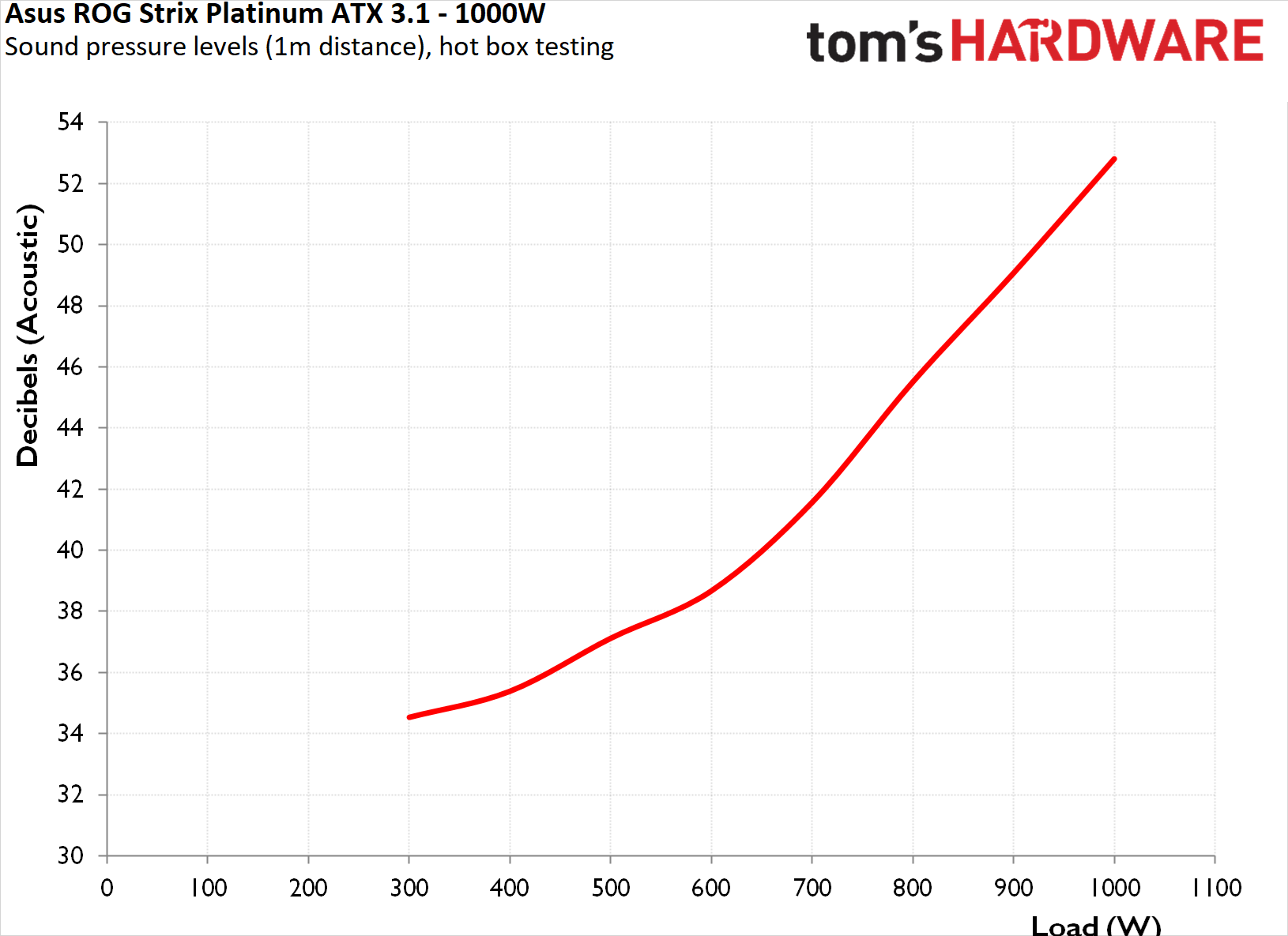
Fan activation shifted to near 300 W under hot conditions, engaging earlier to maintain safe internal temperatures. Ramp‑up was just a little more aggressive but still linear, with the fan hitting its maximum speed only if the unit is fully loaded for a significant amount of time. The low maximum speed of the fan prevents it from rising the dB(A) readings too high, although the ball-bearing engine is clearly audible when the unit is heavily loaded. The internal temperatures of the unit remain very low.
PSU Quality and Bottom Line
Power Supply Quality
The Asus ROG Strix 1000P power supply demonstrated great electrical performance and power output quality overall. Ripple measurements under full‑load conditions revealed maximum peak‑to‑peak deviations of 28 mV on the 12 V rail, 12 mV on the 5 V rail, and 20 mV on the 3.3 V rail, all well below the ATX 3.1 specification limits of 120 mV, 50 mV, and 50 mV, respectively. The voltage ripple filtering is outstanding, with very low mV figures on the 12V voltage line. Asus slightly neglected the 3.3V line, which is very well within the expected performance parameters, but clearly not as well regulated and filtered as the 5V and 12V lines.
During our thorough assessment, we evaluate the essential protection features of every power supply unit we review, including Over Current Protection (OCP), Over Voltage Protection (OVP), Over Power Protection (OPP), and Short Circuit Protection (SCP). All protection mechanisms were activated and functioned correctly during testing.
The OCP limits were set at 130% for the 3.3V rail, 132% for the 5V rail, and 116% for the 12V rail, while Over Power Protection (OPP) triggered at 116% under hot conditions. The protection features work very well, with the OCP/OPP triggers modestly set for an ATX 3.1 unit.
Load (Watts) | 201.24W | Row 0 - Cell 2 | 502.05W | Row 0 - Cell 4 | 751.8W | Row 0 - Cell 6 | 1001.25W | Row 0 - Cell 8 |
Load (Percent) | 20.12% | Row 1 - Cell 2 | 50.12% | Row 1 - Cell 4 | 75.18% | Row 1 - Cell 6 | 100.12% | Row 1 - Cell 8 |
Amperes | Volts | Amperes | Volts | Amperes | Volts | Amperes | Volts | |
3.3 V | 2.27 | 3.36 | 5.66 | 3.35 | 8.5 | 3.34 | 11.33 | 3.32 |
5 V | 2.27 | 5.07 | 5.66 | 5.05 | 8.5 | 5.04 | 11.33 | 5.02 |
12 V | 15.1 | 12.06 | 37.75 | 12.04 | 56.62 | 12.02 | 75.5 | 12.01 |
| Row 6 - Cell 0 | Row 6 - Cell 1 | Row 6 - Cell 2 | Row 6 - Cell 3 | Row 6 - Cell 4 | Row 6 - Cell 5 | Row 6 - Cell 6 | Row 6 - Cell 7 | Row 6 - Cell 8 |
Line | Regulation (20% to 100% load) | Voltage Ripple (mV) | Row 0 - Cell 3 | Row 0 - Cell 4 | Row 0 - Cell 5 | Row 0 - Cell 6 | Row 0 - Cell 7 |
| Row 1 - Cell 0 | Row 1 - Cell 1 | 20% Load | 50% Load | 75% Load | 100% Load | CL1 12V | CL2 3.3V + 5V |
3.3V | 1.1% | 10 | 8 | 16 | 20 | 12 | 20 |
5V | 1% | 12 | 8 | 10 | 12 | 10 | 12 |
12V | 0.4% | 12 | 16 | 20 | 28 | 26 | 20 |
Bottom Line
The Asus ROG Strix 1000P ATX 3.1 is a premium power supply unit clearly tailored to the gaming and enthusiast demographic, with a particular appeal to younger audiences and PC modders who seek aggressive styling as much as performance. With its striking aesthetic, including interchangeable color accents, decorative chrome cutouts, and a stylized “STRIX” fan grille, the unit prioritizes visual presence, but not at the expense of functionality.
It is fully modular and equipped with flexible, individually sleeved cables, making it suitable for clean builds with an emphasis on appearance. However, the total number of connectors is relatively conservative for a 1000-Watt PSU, limiting expansion for systems with multiple GPUs or large peripheral arrays. Features like the 12V-2x6 cable’s purple voltage-sensing pin attempt to introduce innovation, though the practical benefits of this remain questionable. The GPU voltage stabilizer feature seems to be a marketing gimmick more than anything else, and thankfully so. Otherwise, the PSU would be overvolting everything every time the GPU had a significant power demand.
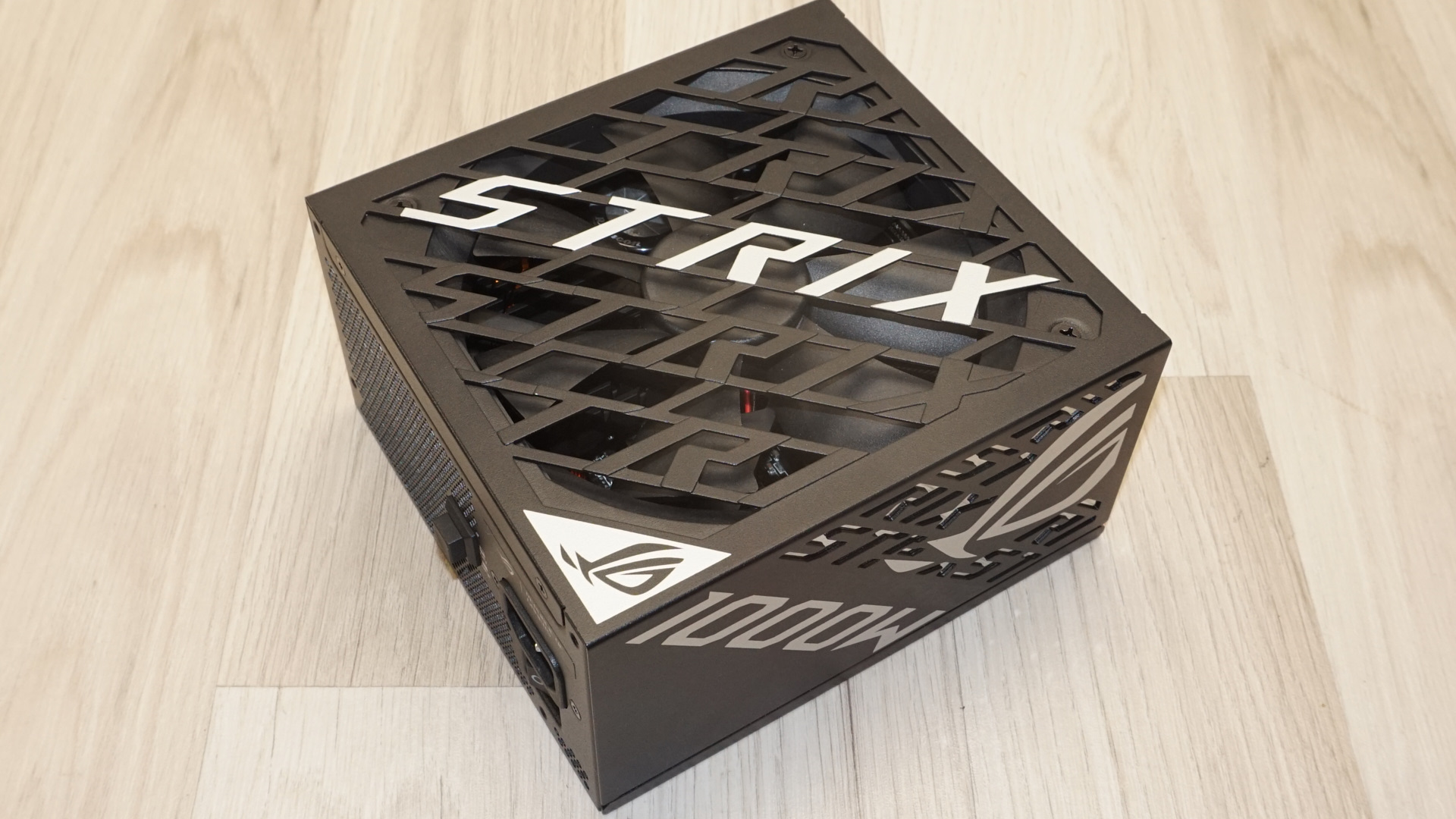
Electrically, the ROG Strix 1000P performs very well and fully complies with the ATX 3.1 specification. Voltage regulation is excellent, staying within 0.4% for the 12 V rail and just above 1% for the minor rails. Ripple suppression is also impressive, with values of 28 mV for the 12 V rail, 12 mV for the 5 V, and 20 mV for the 3.3 V rail, all well below industry limits. These figures point to a design built for power delivery stability, suitable for high-end gaming PCs and workstations. The OCP and OPP protection features function correctly, with the trigger points modestly set for safety.
Regarding thermal and acoustic performance, the Strix 1000P maintains very low internal temperatures, mostly because of its oversized heatsinks. Despite the fan’s dual ball bearing design, it only becomes audible under high loads or in very adverse environments. The zero-RPM mode is effective, keeping the unit dead silent up to around 300–400 watts, depending on ambient conditions. Once the fan is active, it ramps gradually and does not reach its maximum unless the PSU is heavily loaded for an extended period. However, when it does reach higher speeds, the fan’s bearing noise becomes noticeable.
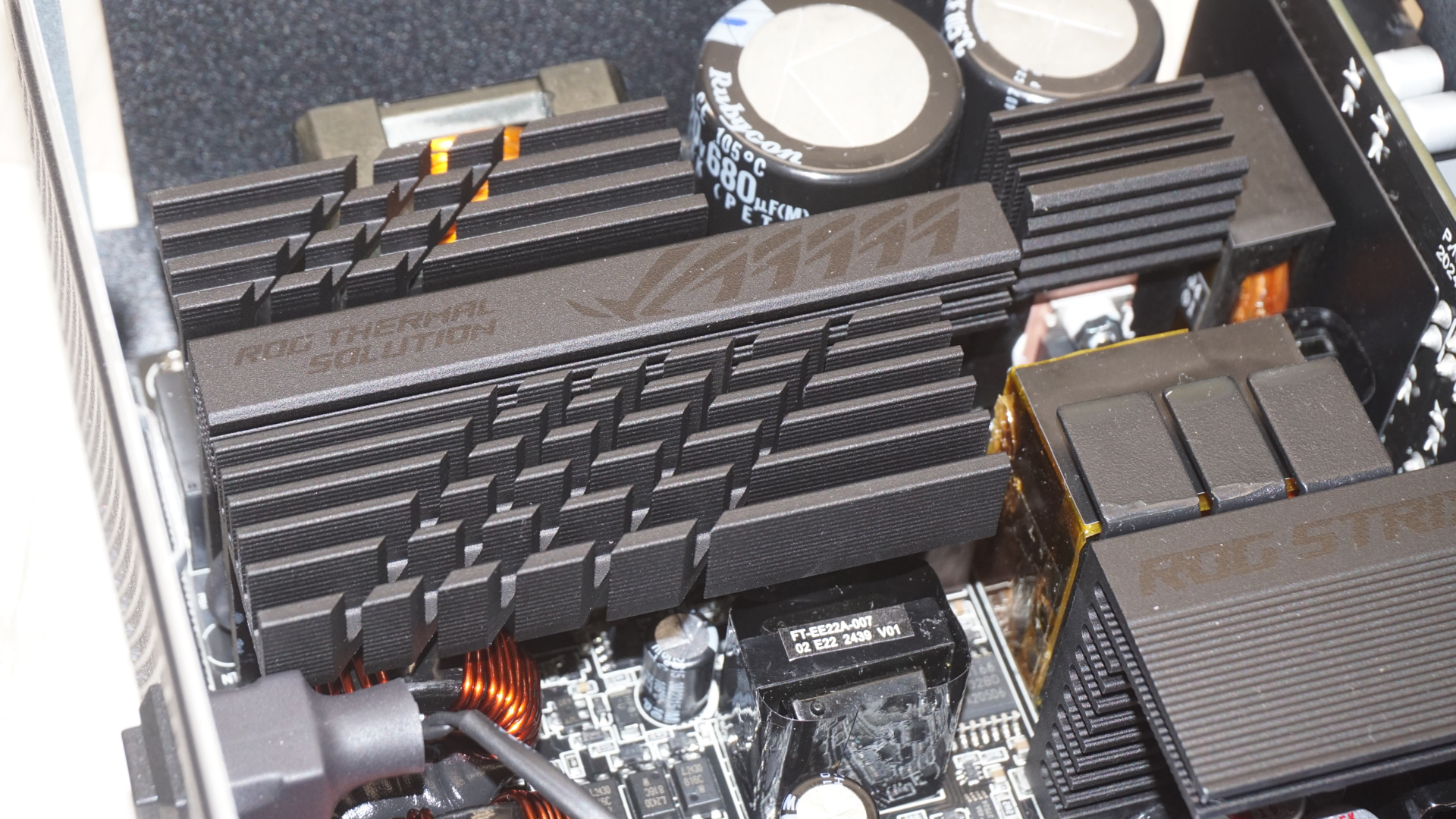
In conclusion, the Asus ROG Strix 1000P is a well-engineered PSU that delivers excellent electrical performance and respectable thermal behavior. Its standout visual design and customization options are certainly meant to attract its intended gaming audience, though its very aggressive design and some design choices, such as the use of a ball bearing fan and the inclusion of the voltage-sensing pin, may raise questions about necessity versus marketing. At $280 for the black version and $235 for the white at the time of this review, it is priced significantly higher than other units with similar performance. While it does include a 10-year warranty, potential buyers should carefully weigh whether the aesthetic enhancements and brand premium justify the extra cost.
MORE: Best Power Supplies
MORE: How We Test Power Supplies
MORE: All Power Supply Content

Dr. E. Fylladitakis has been passionate about PCs since the 8088 era, beginning his PC gaming journey with classics like Metal Mutant and Battle Chess. Not long after, he built his first PC, a 486, and has been an enthusiast ever since. In the early 2000’s, he delved deeply into overclocking Duron and Pentium 4 processors, liquid cooling, and phase-change cooling technologies. While he has an extensive and broad engineering education, Dr. Fylladitakis specializes in electrical and energy engineering, with numerous articles published in scientific journals, some contributing to novel cooling technologies and power electronics. He has been a hardware reviewer at AnandTech for nearly a decade. Outside of his professional pursuits, he enjoys immersing himself in a good philosophy book and unwinding through PC games.
